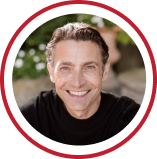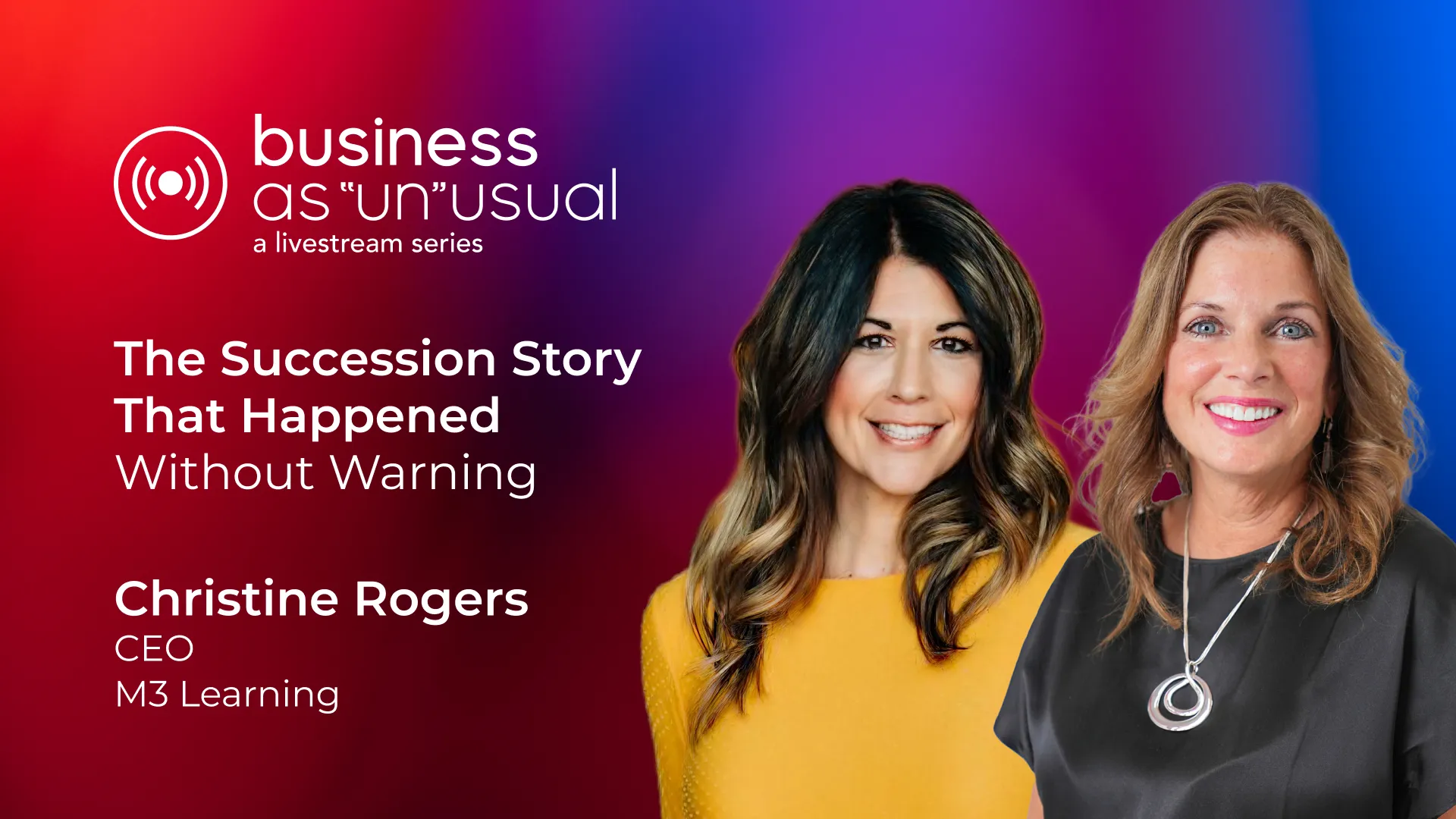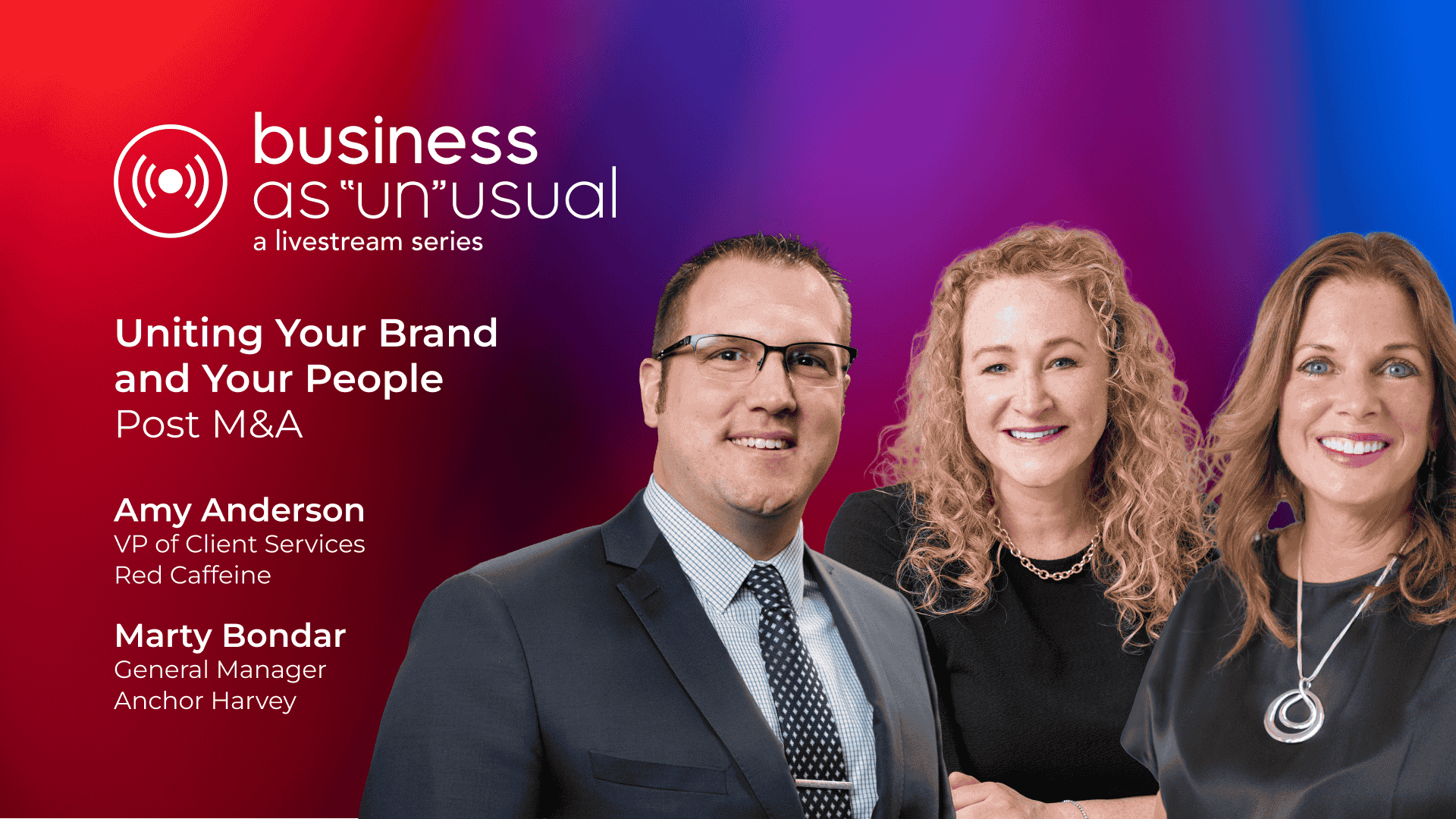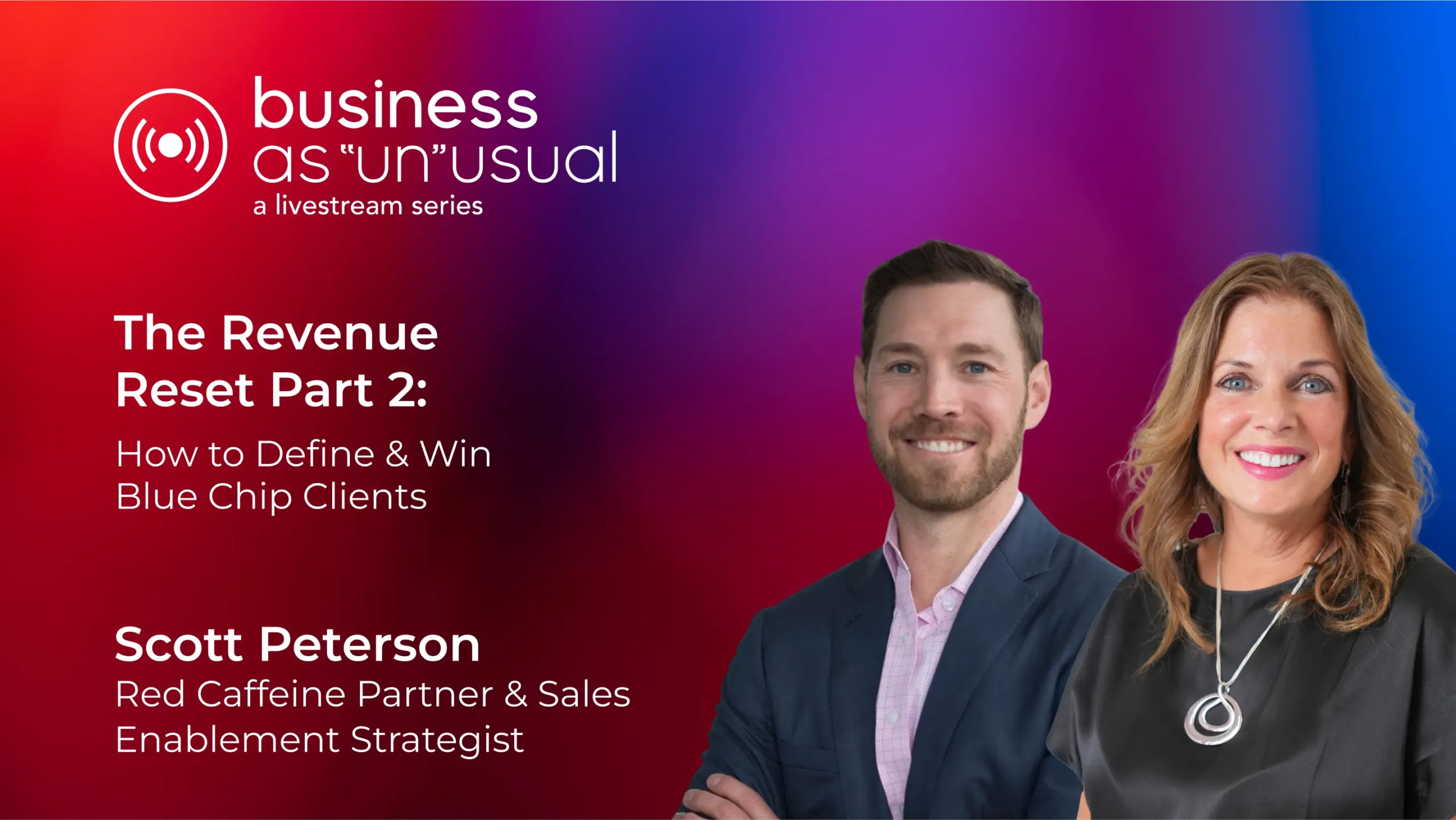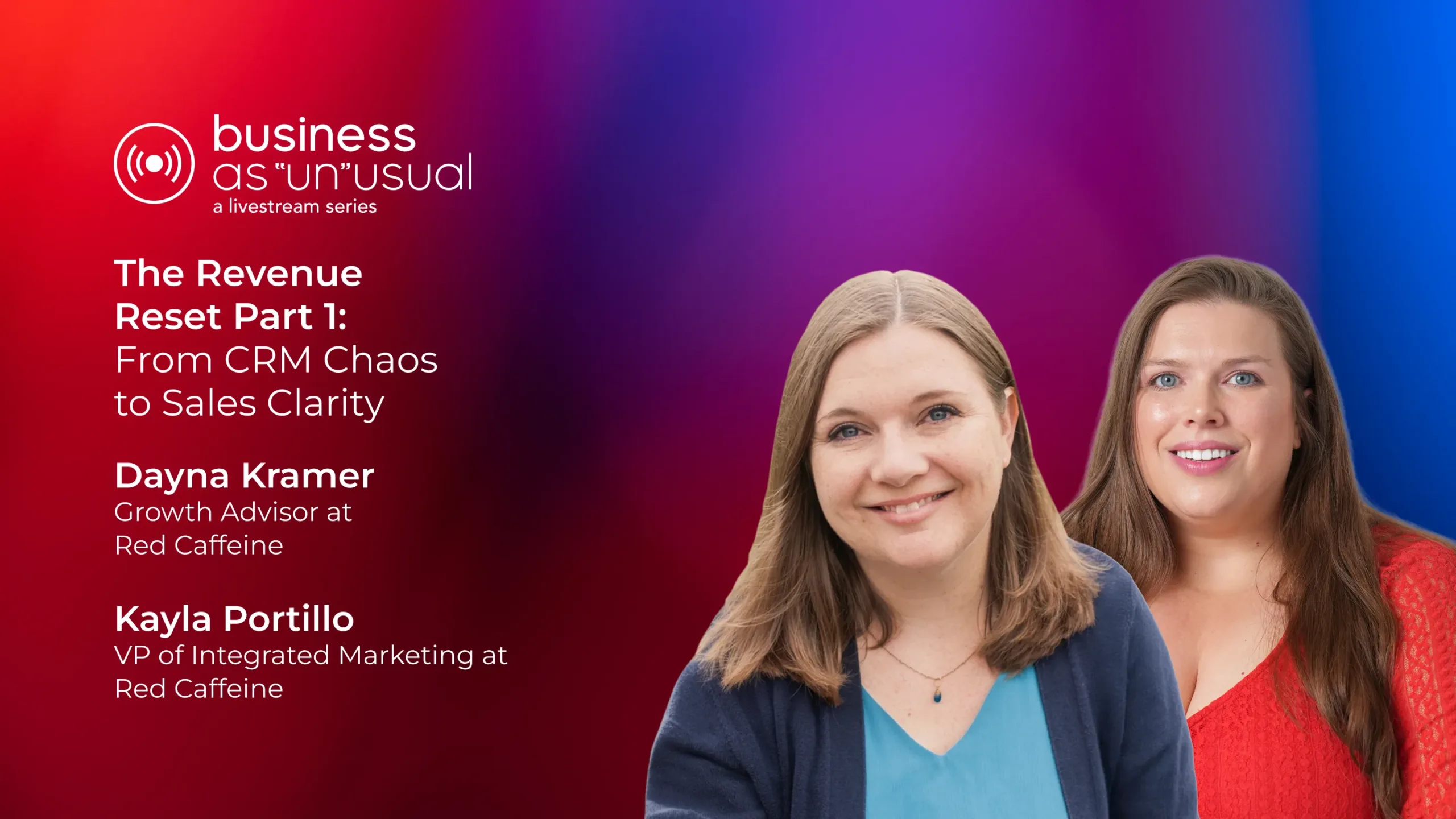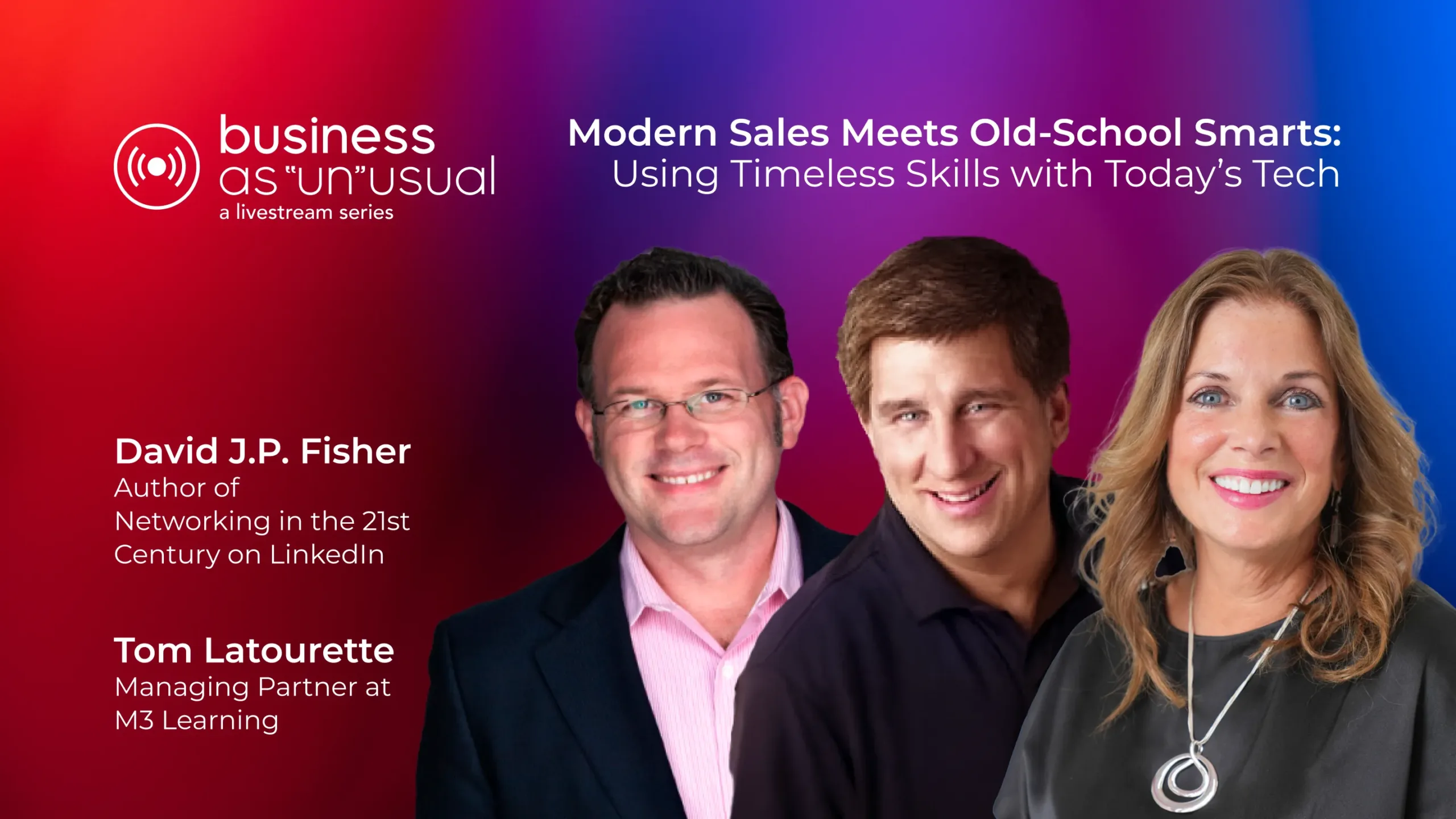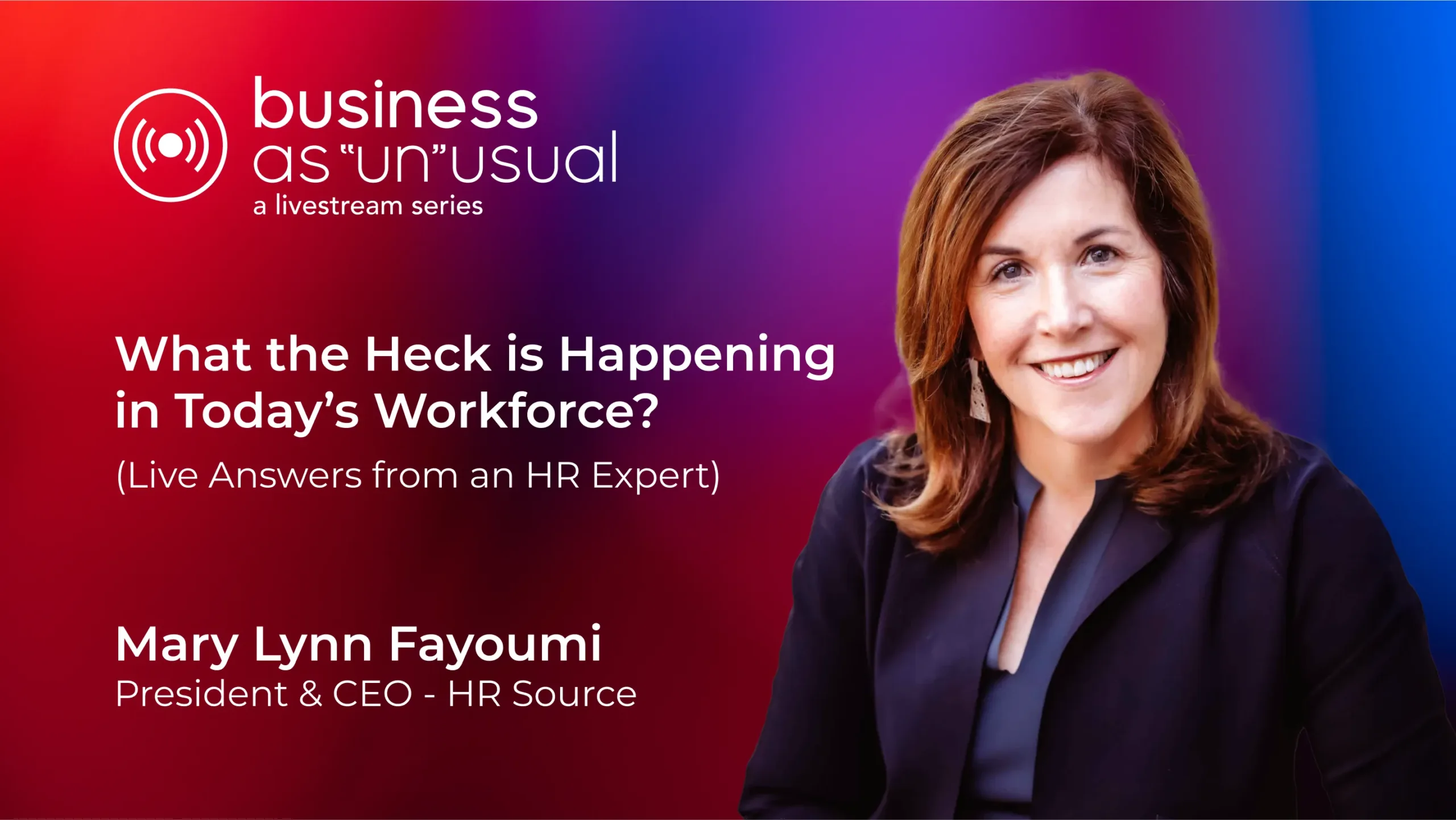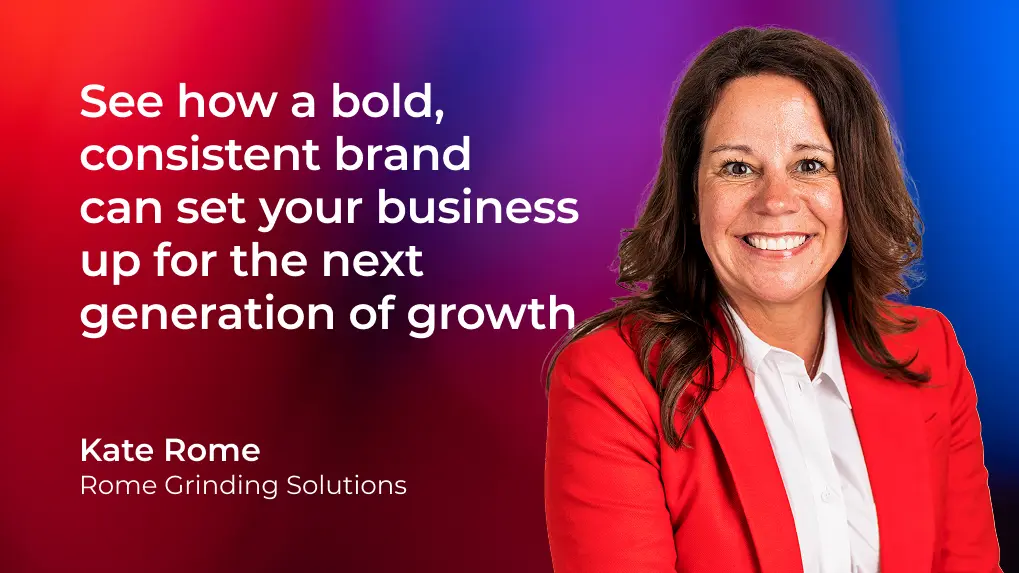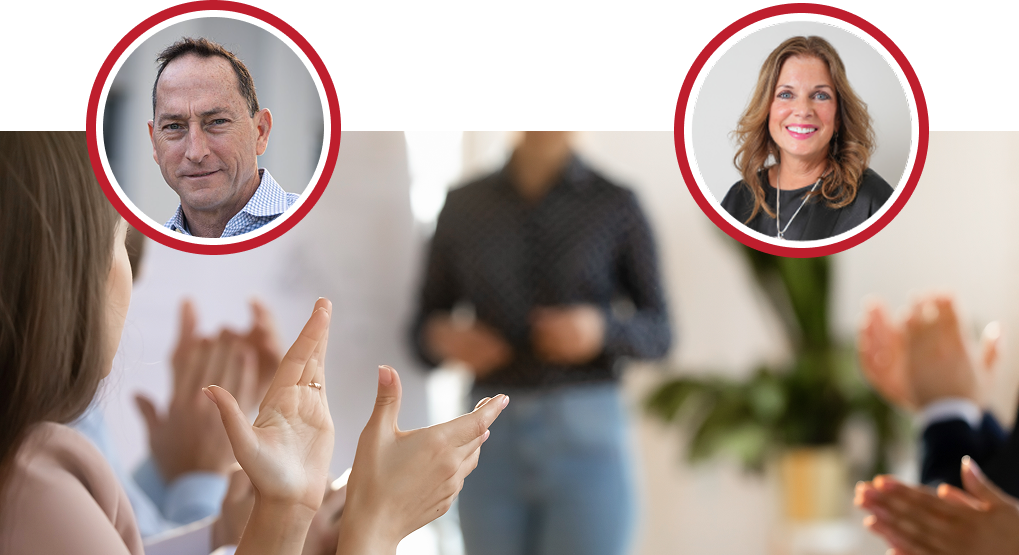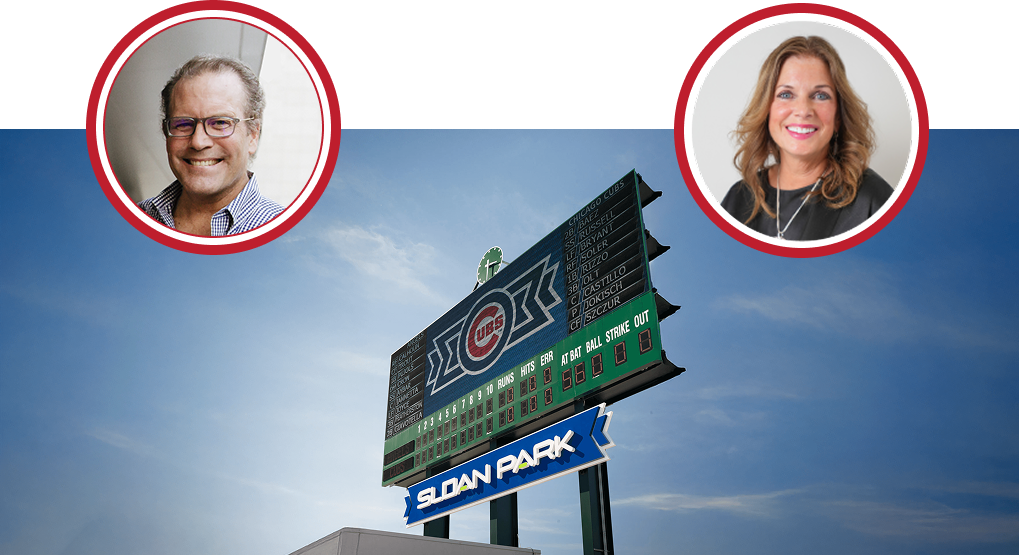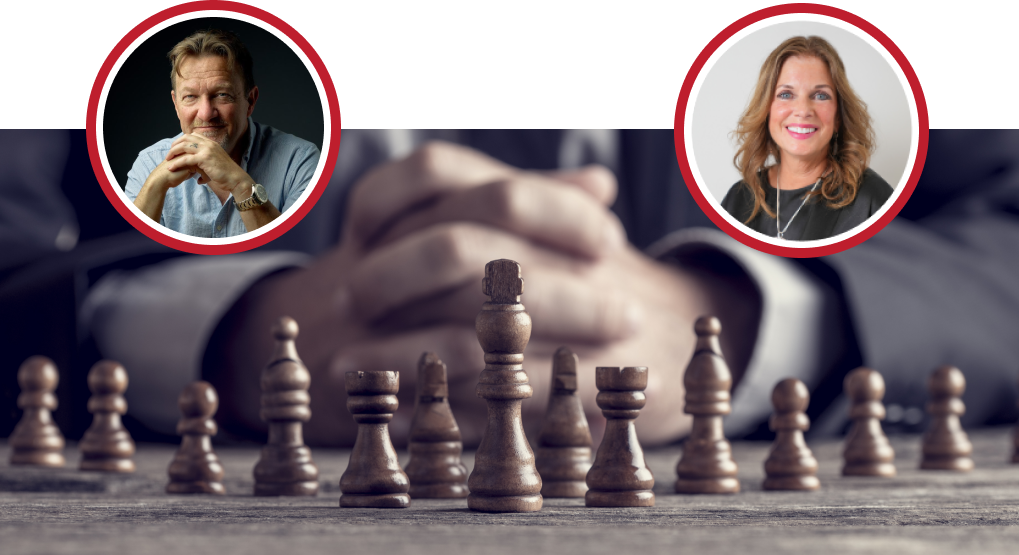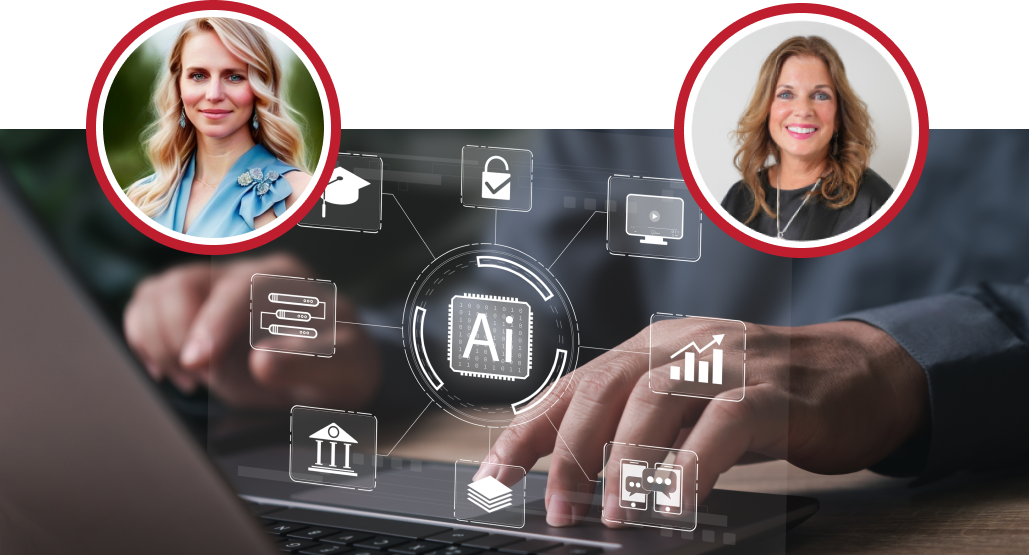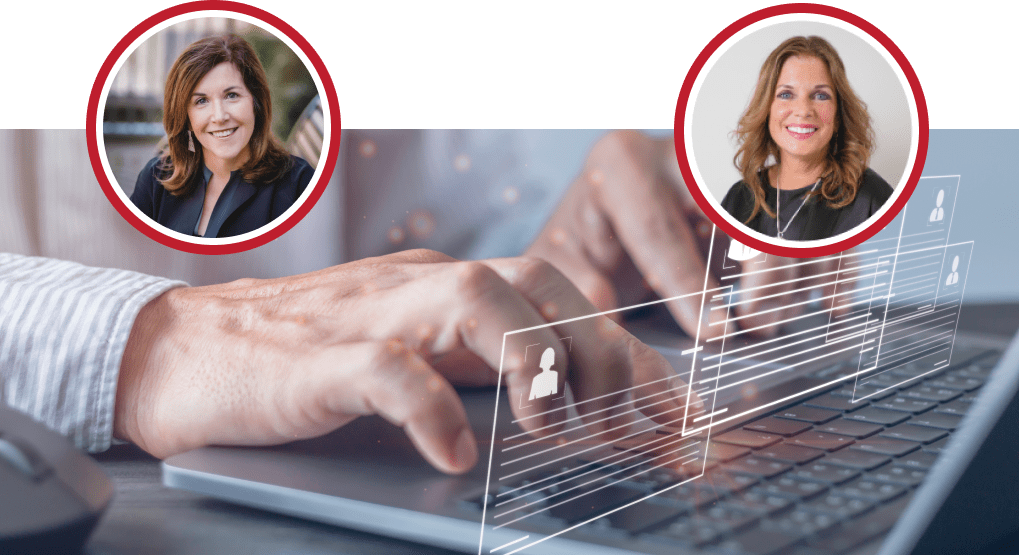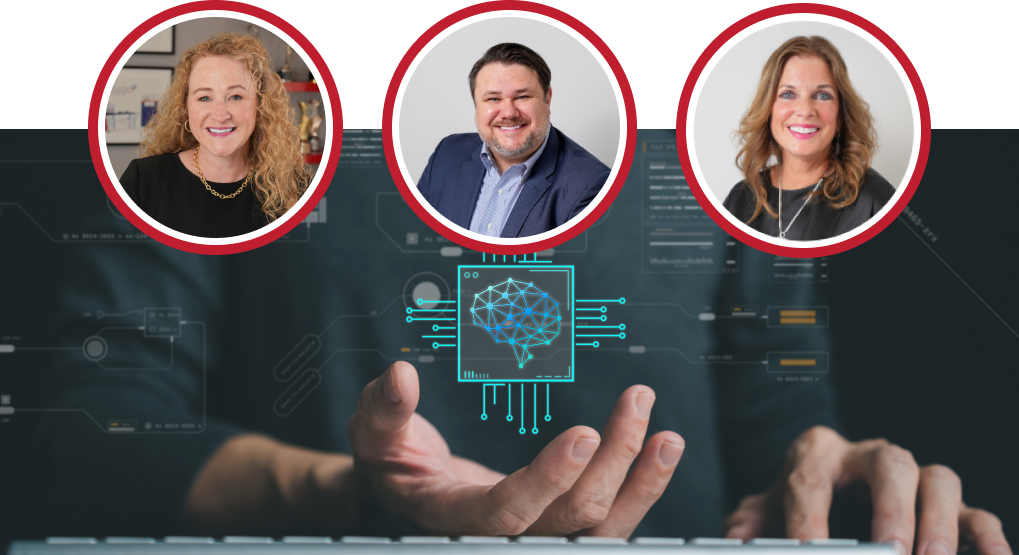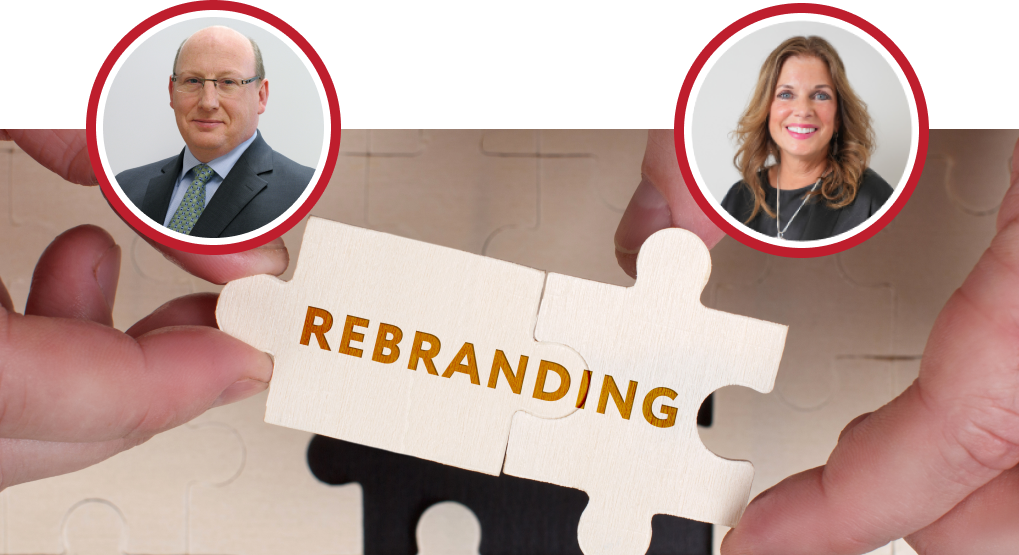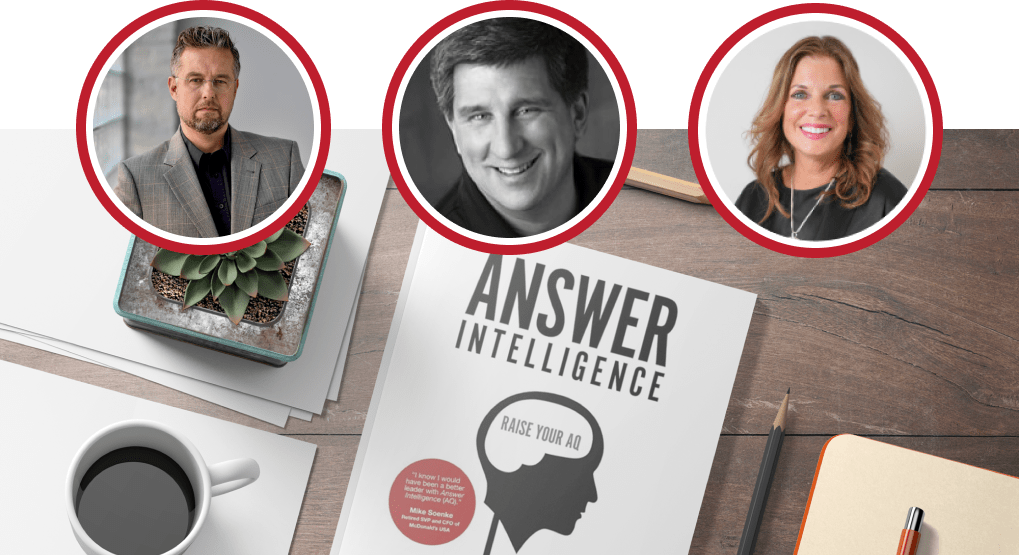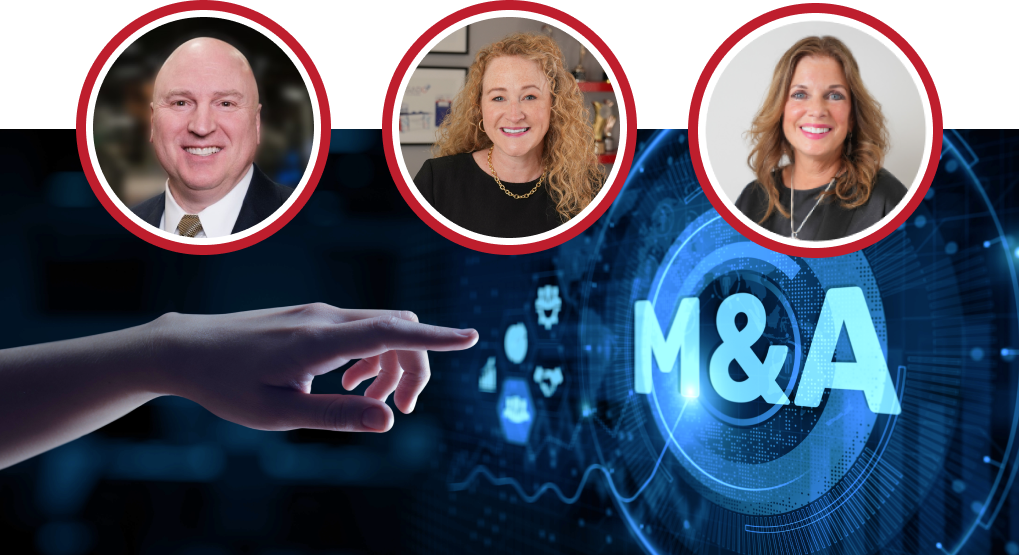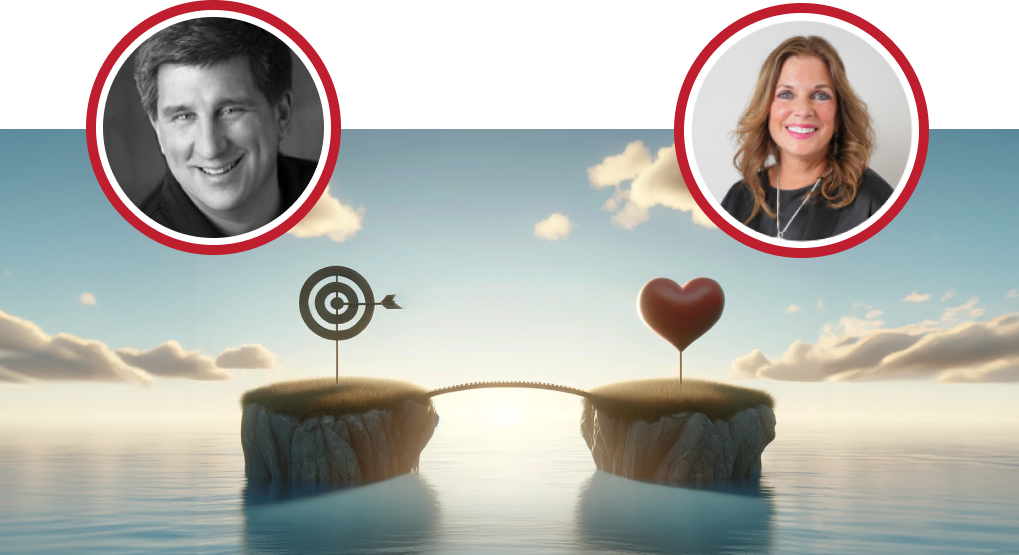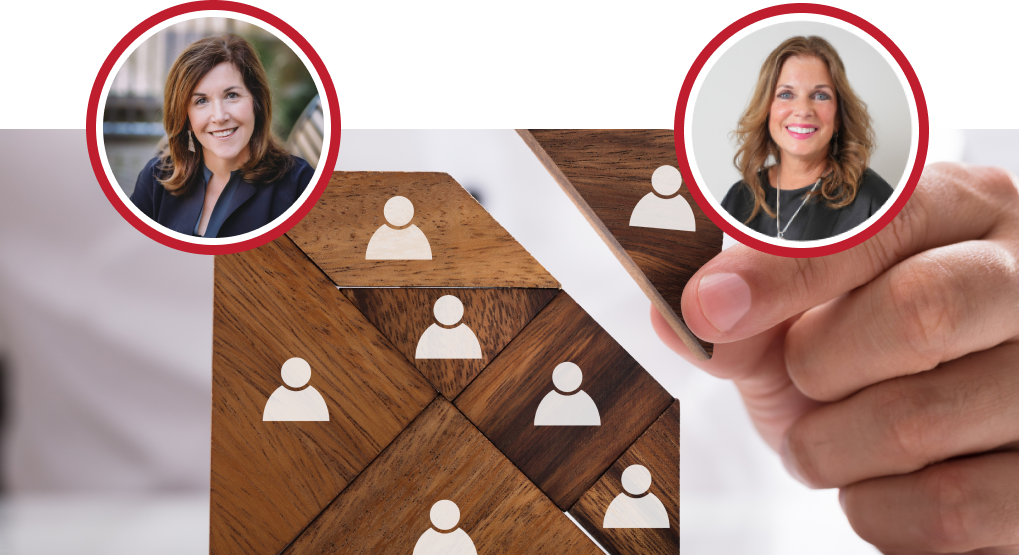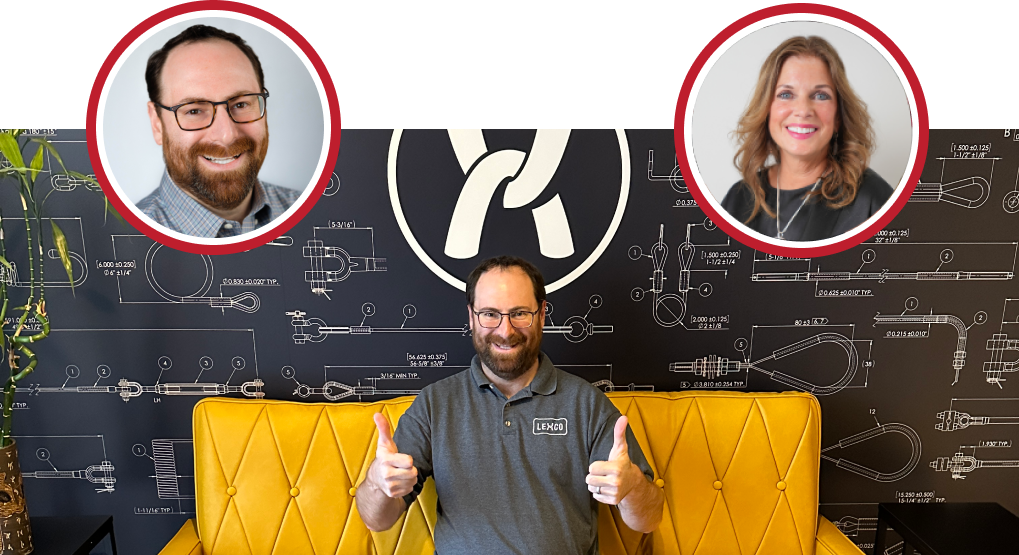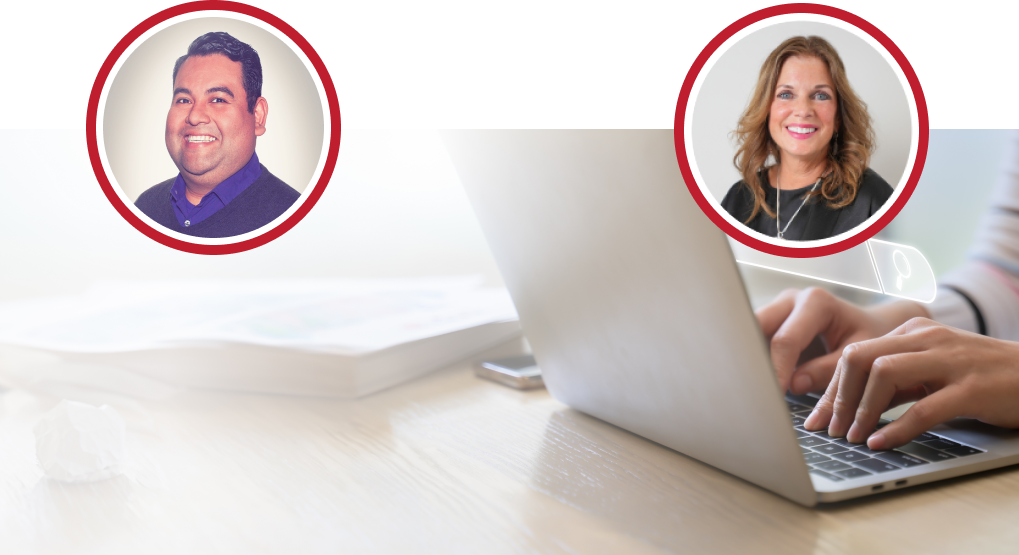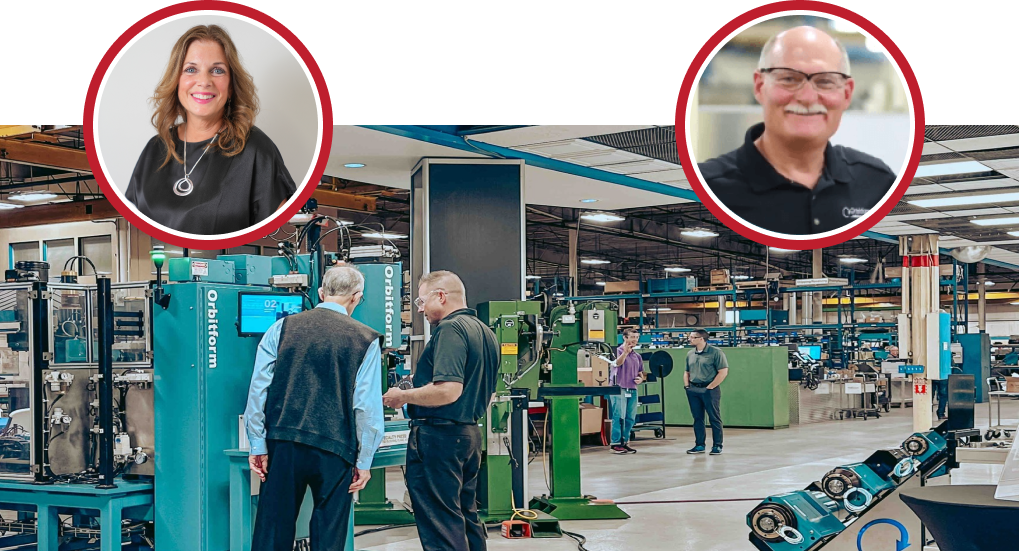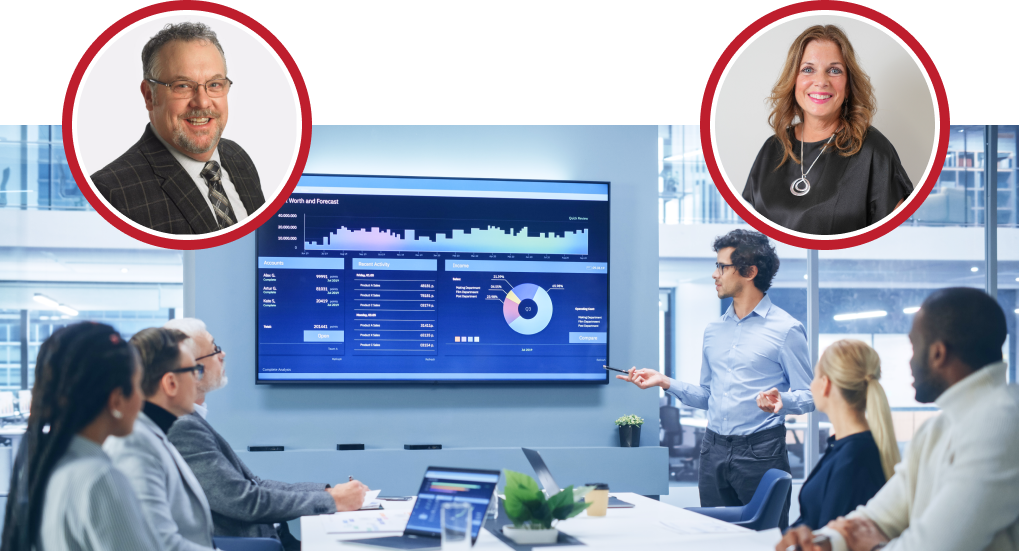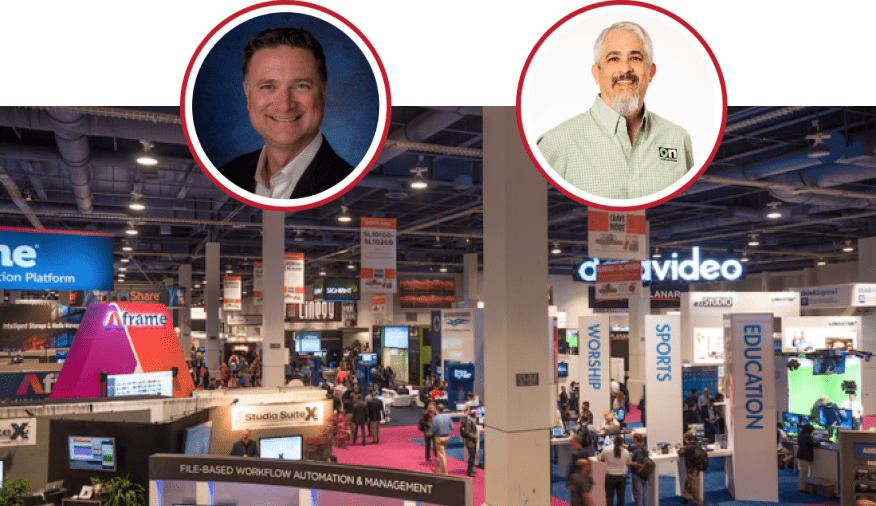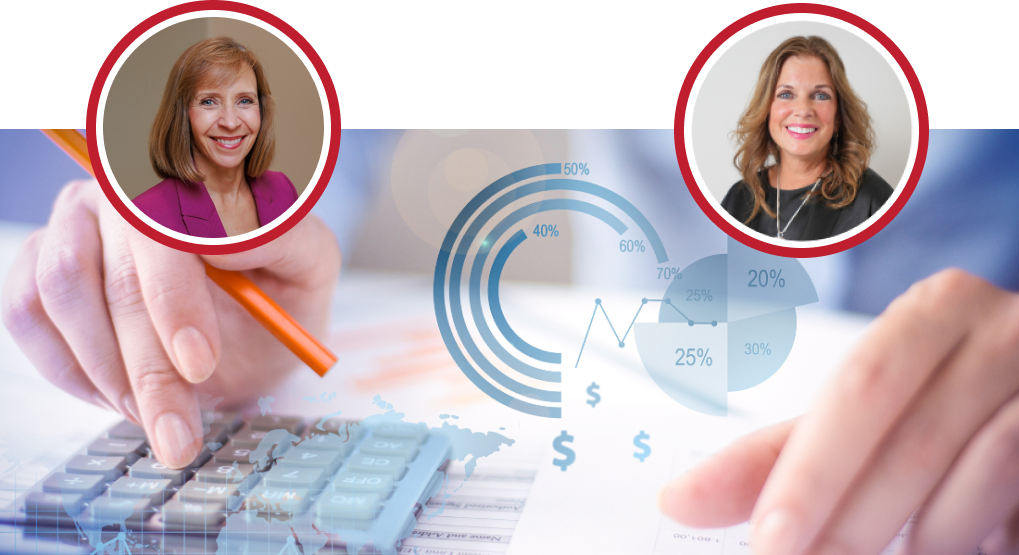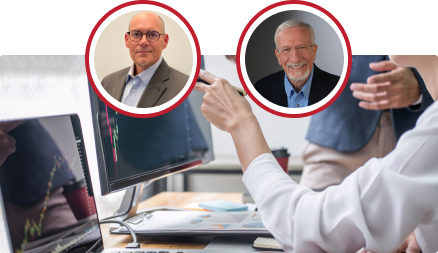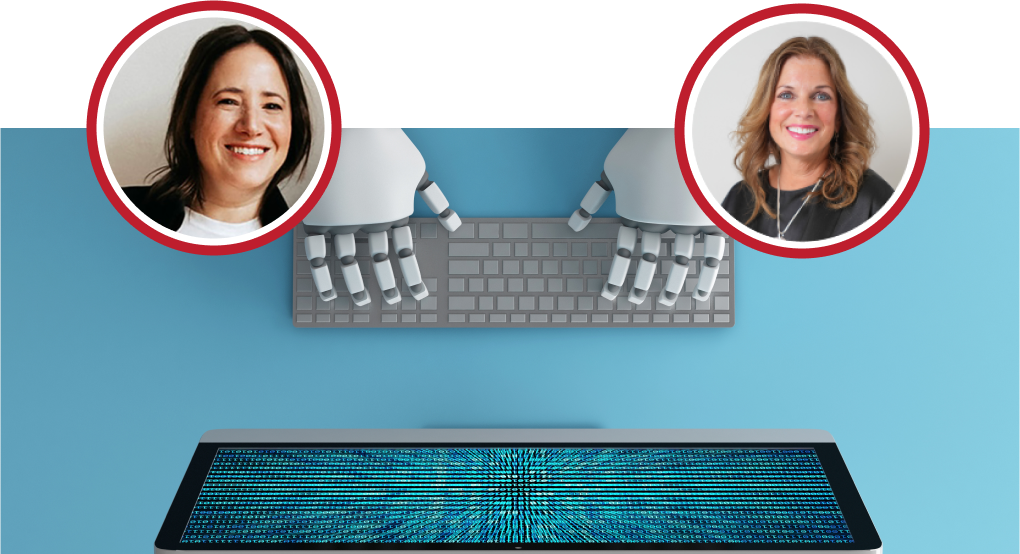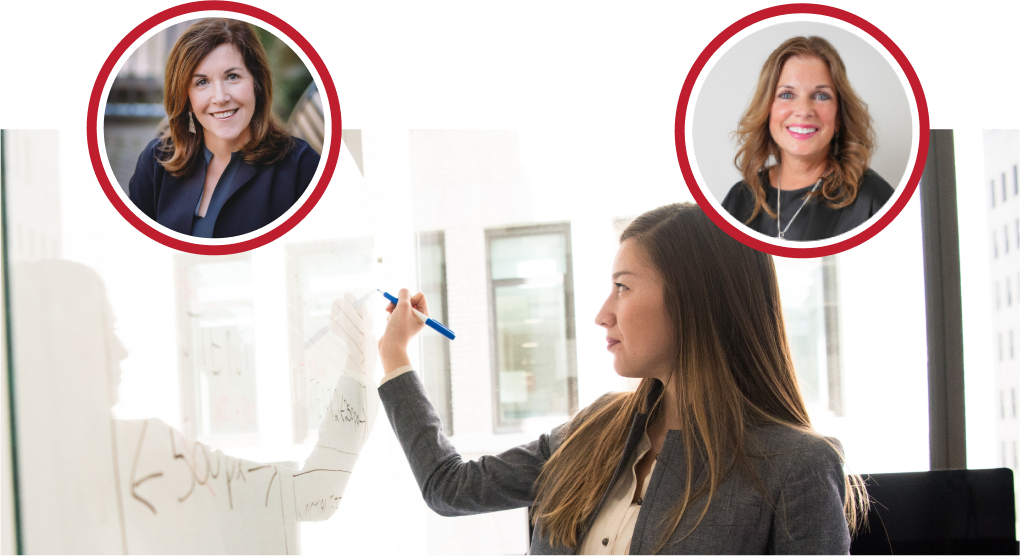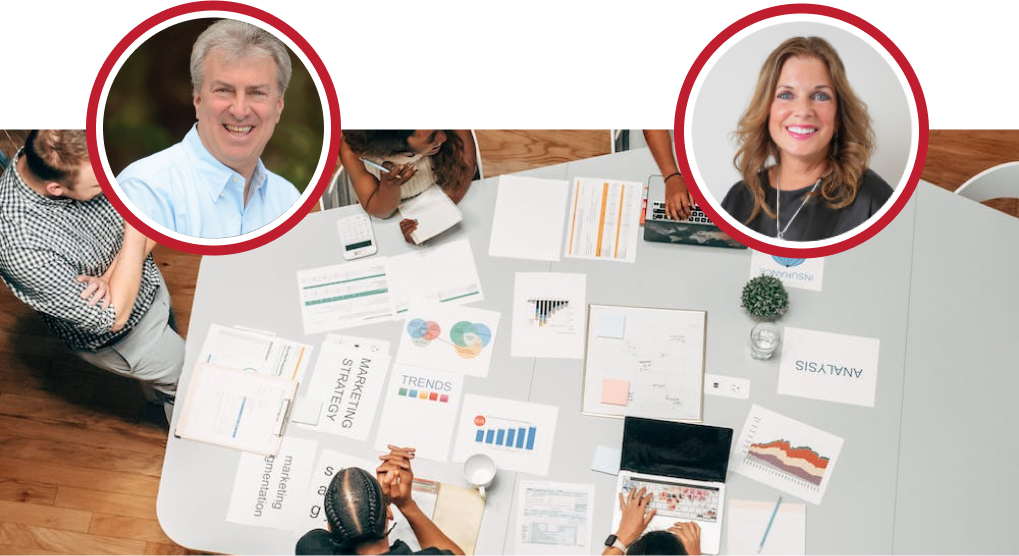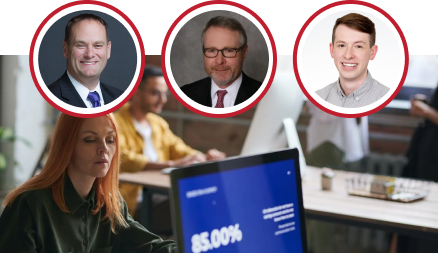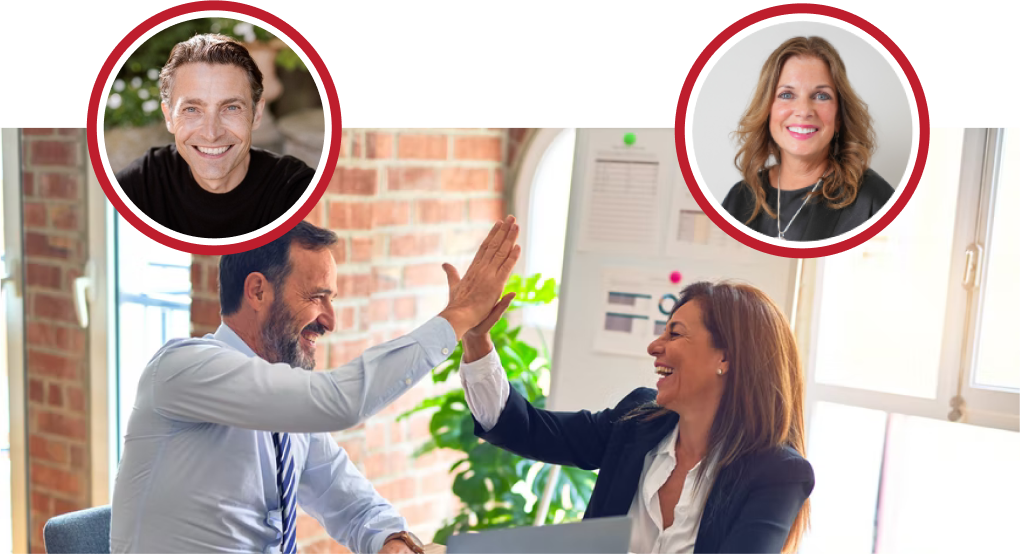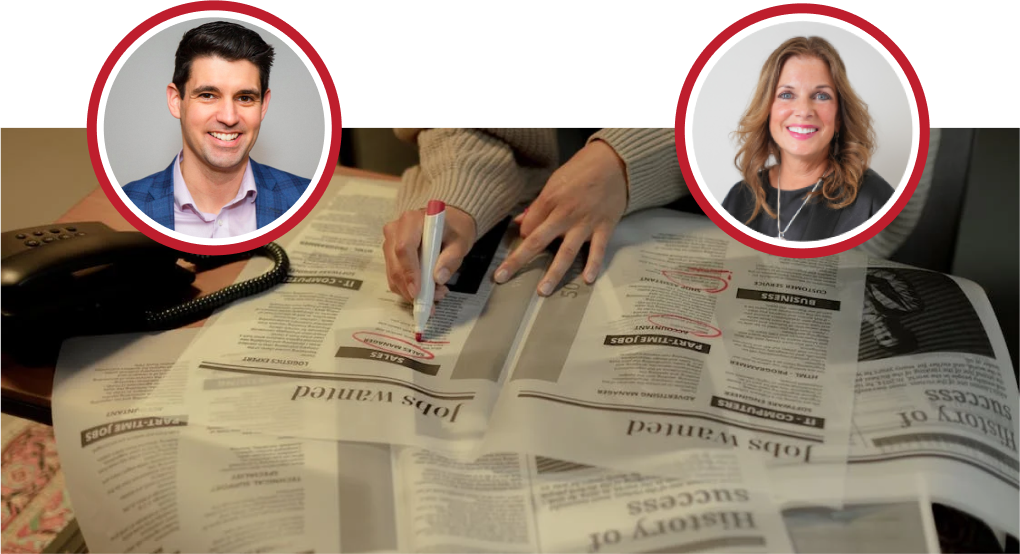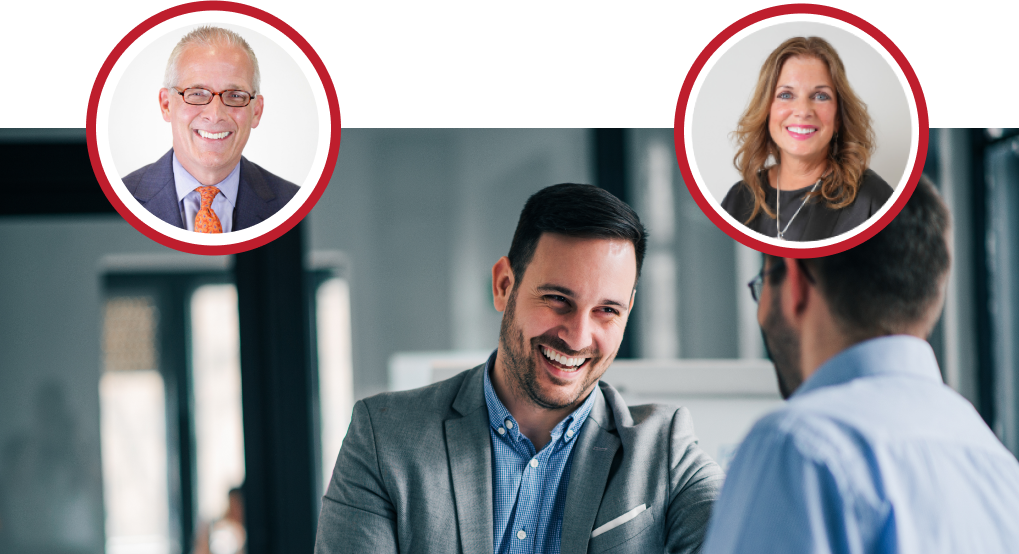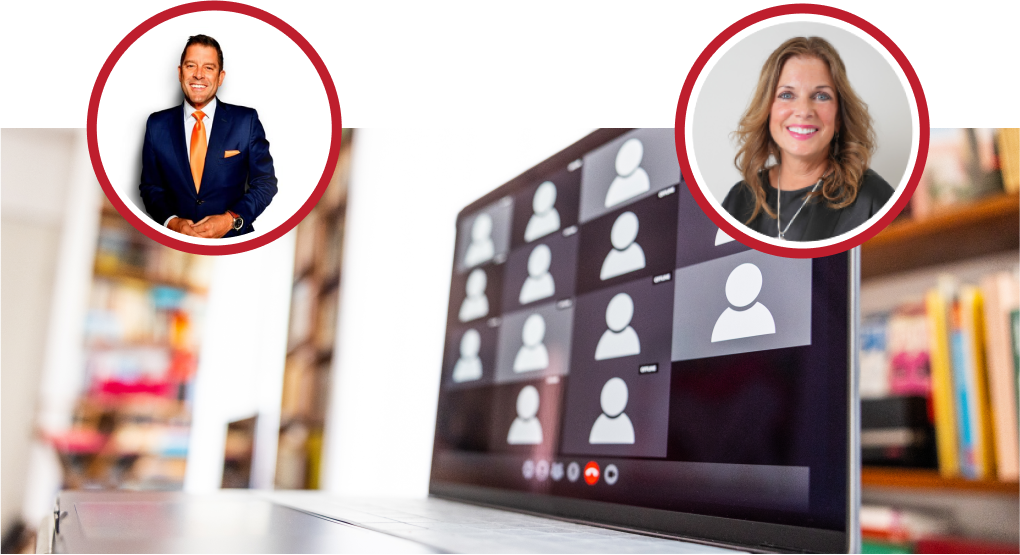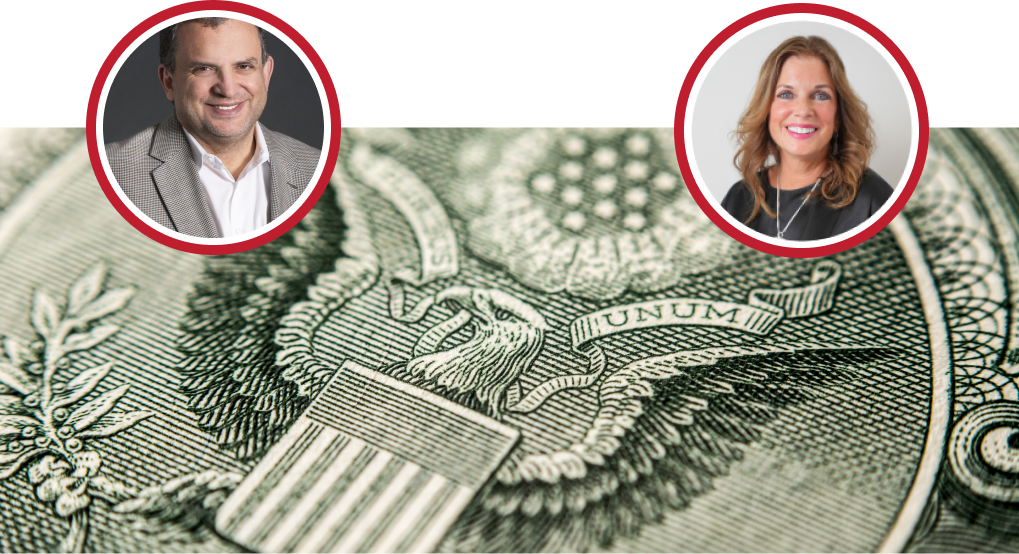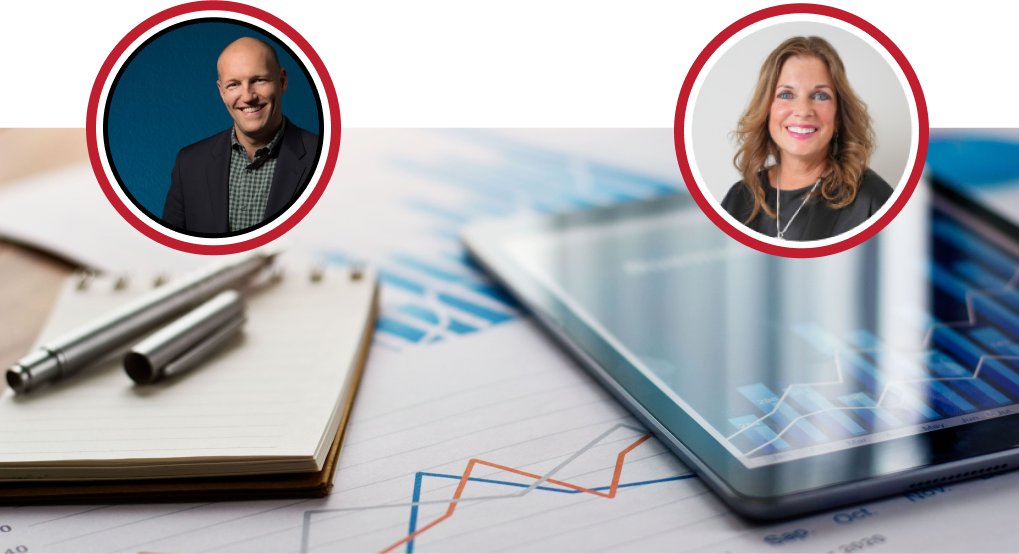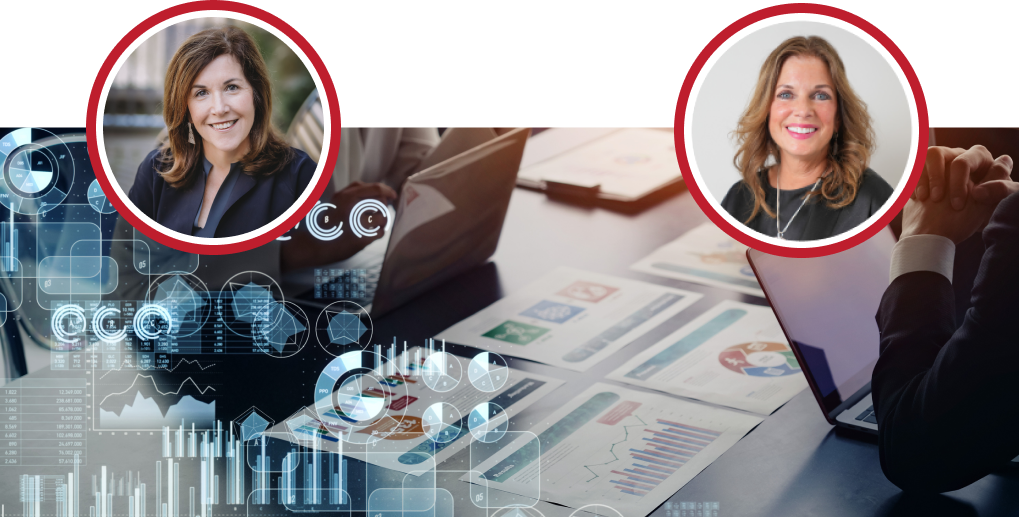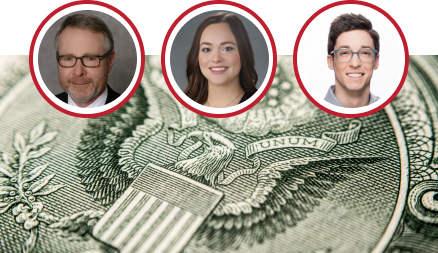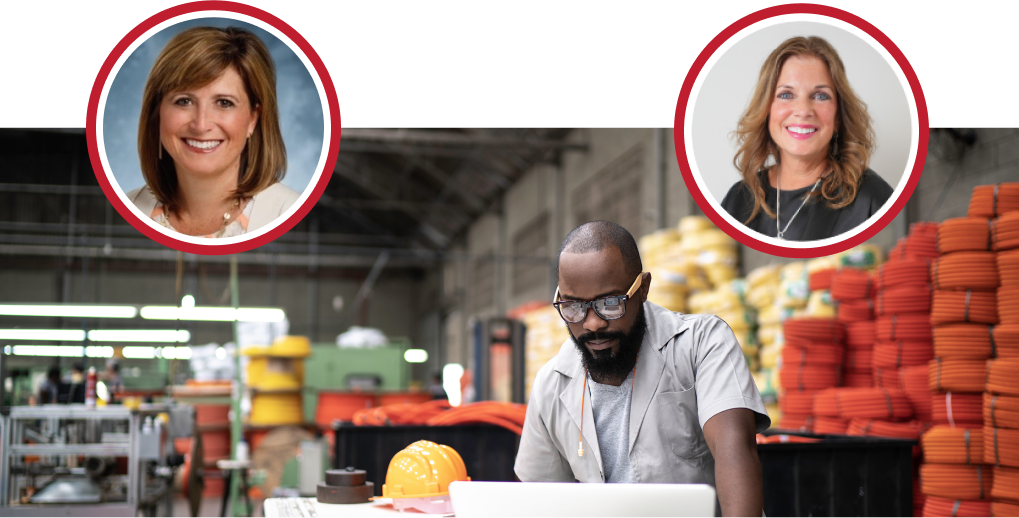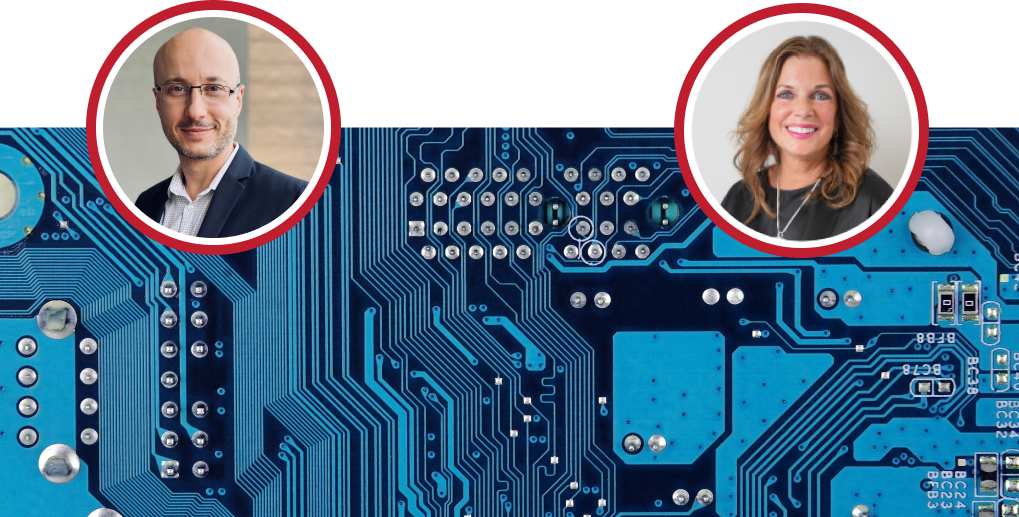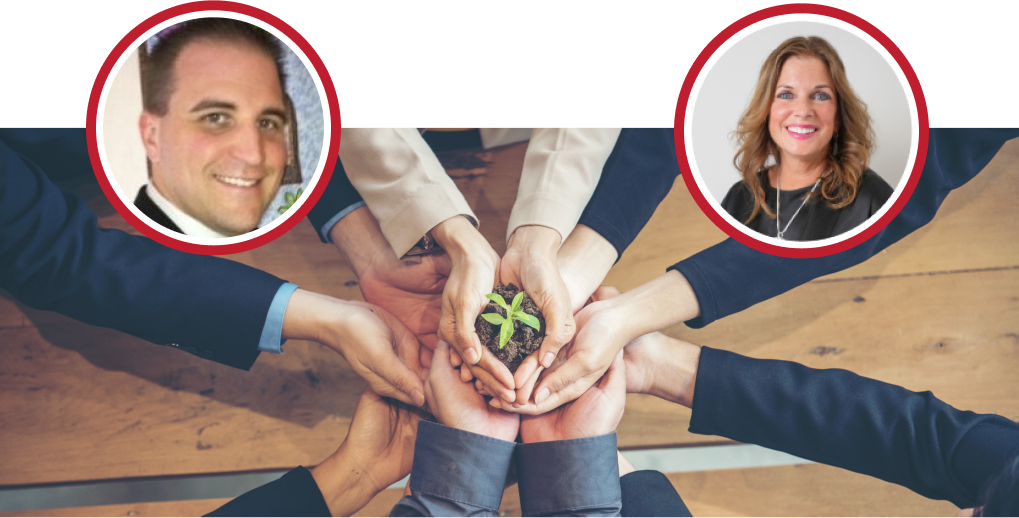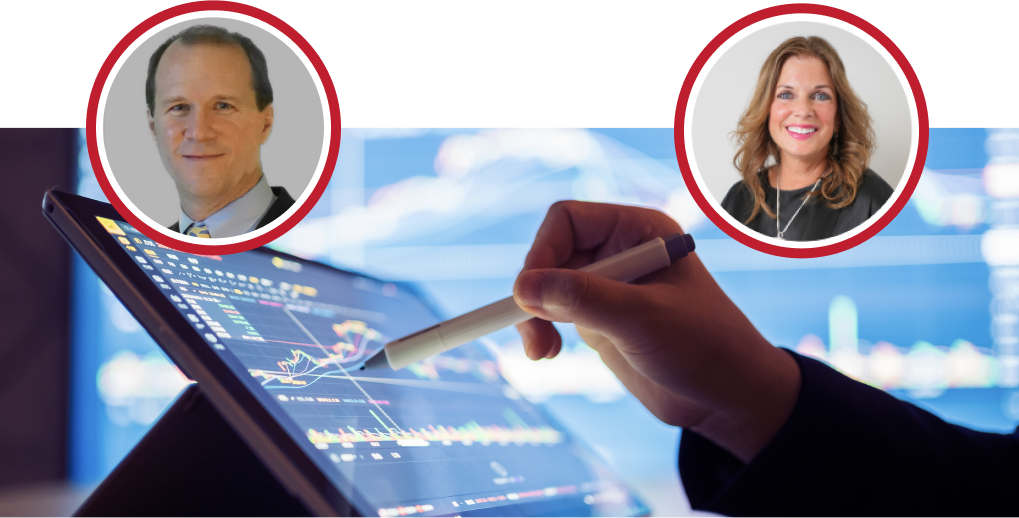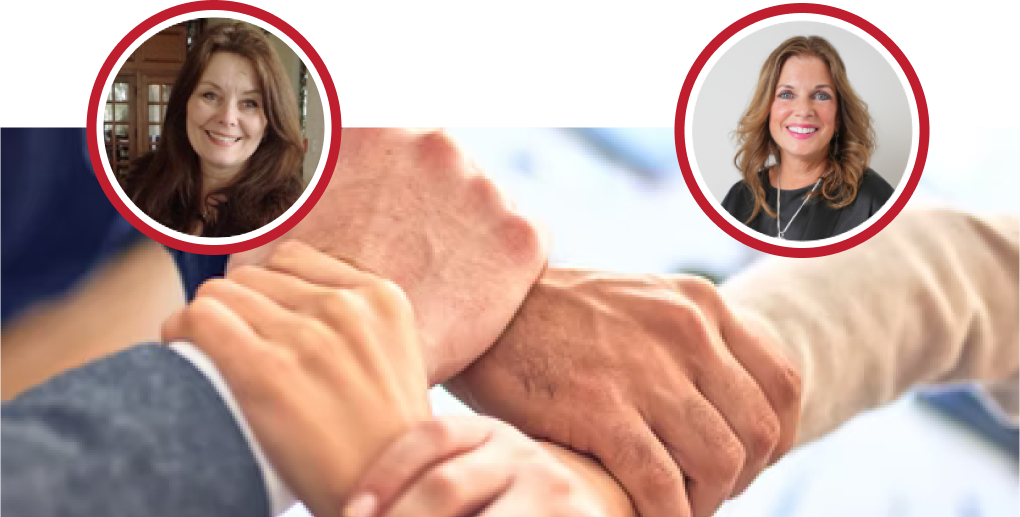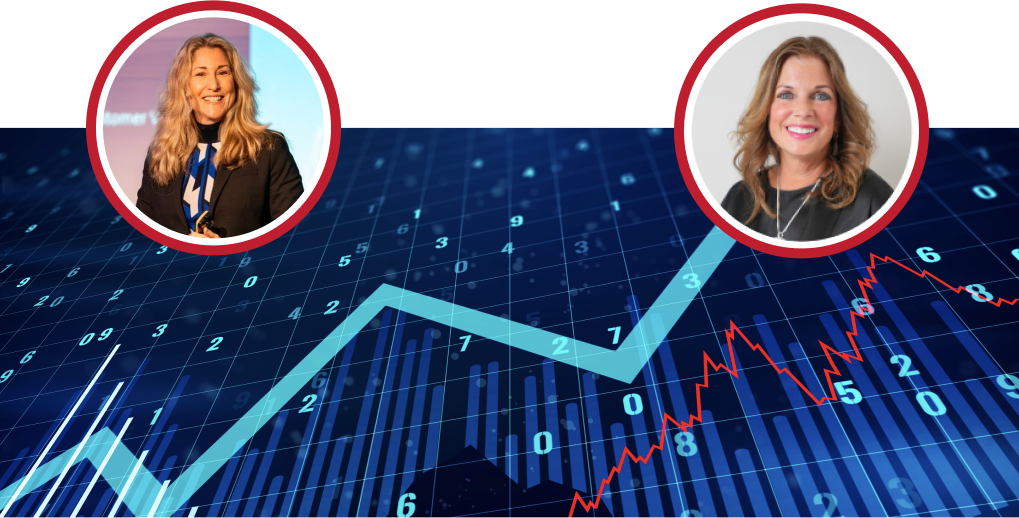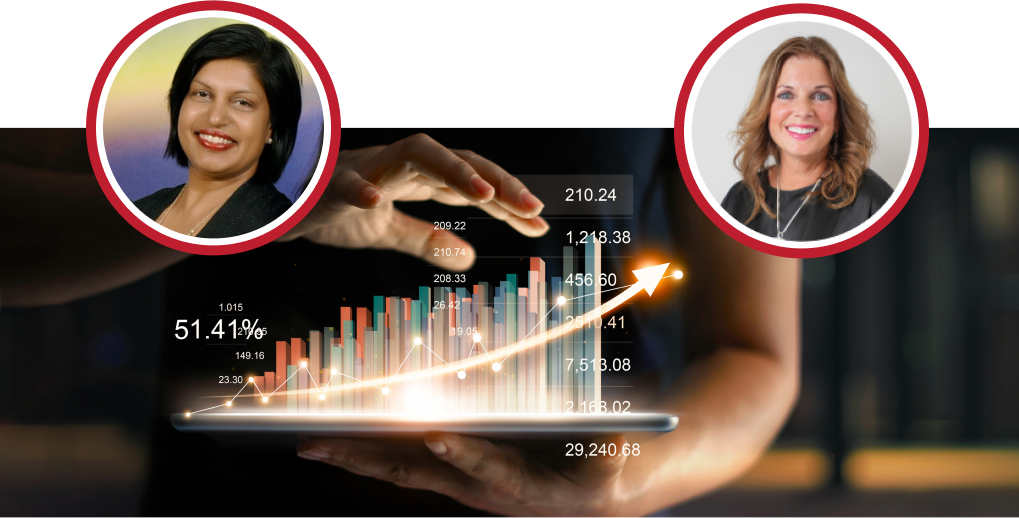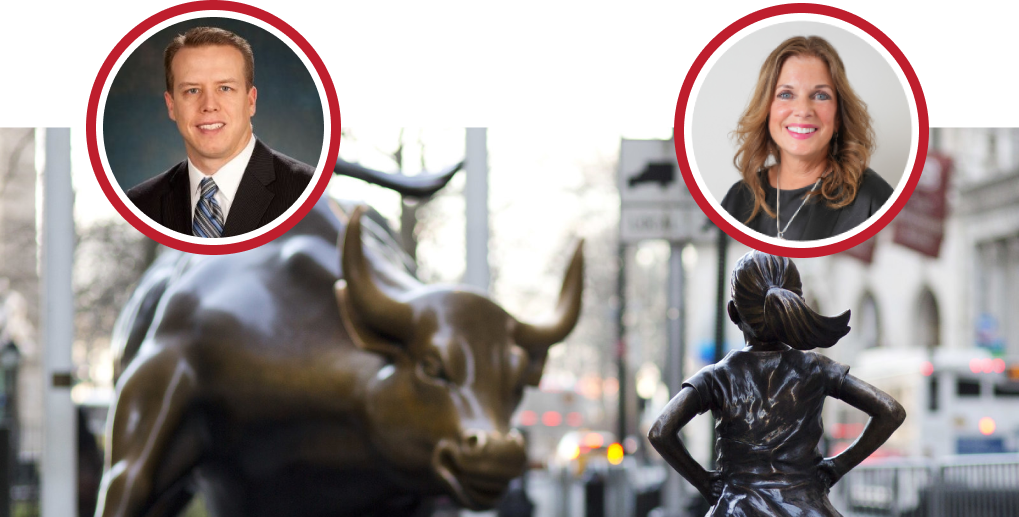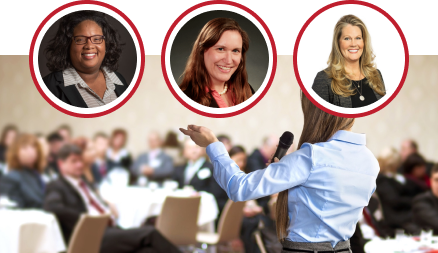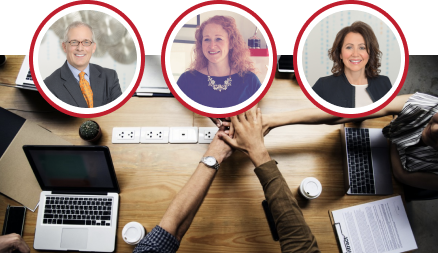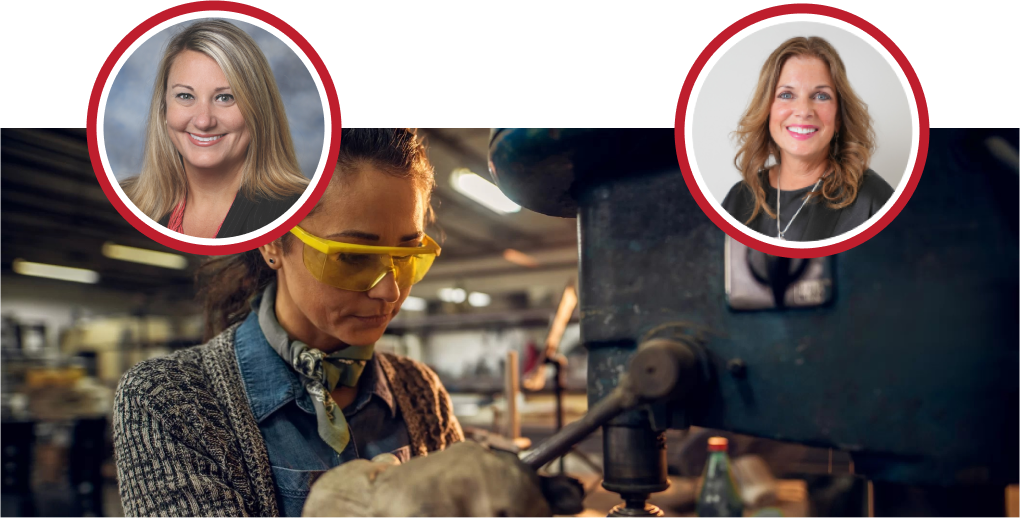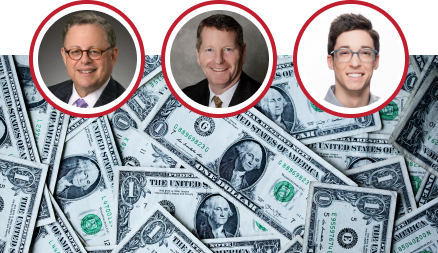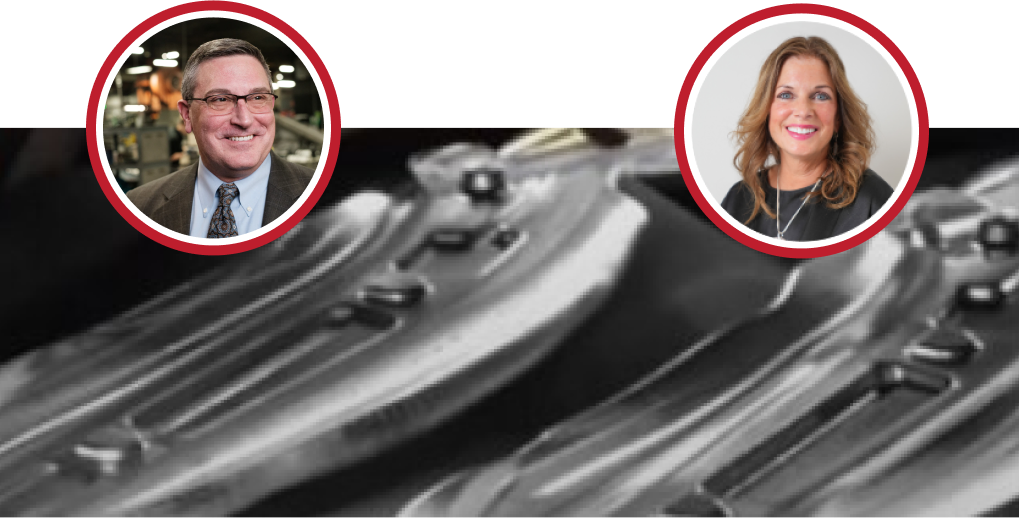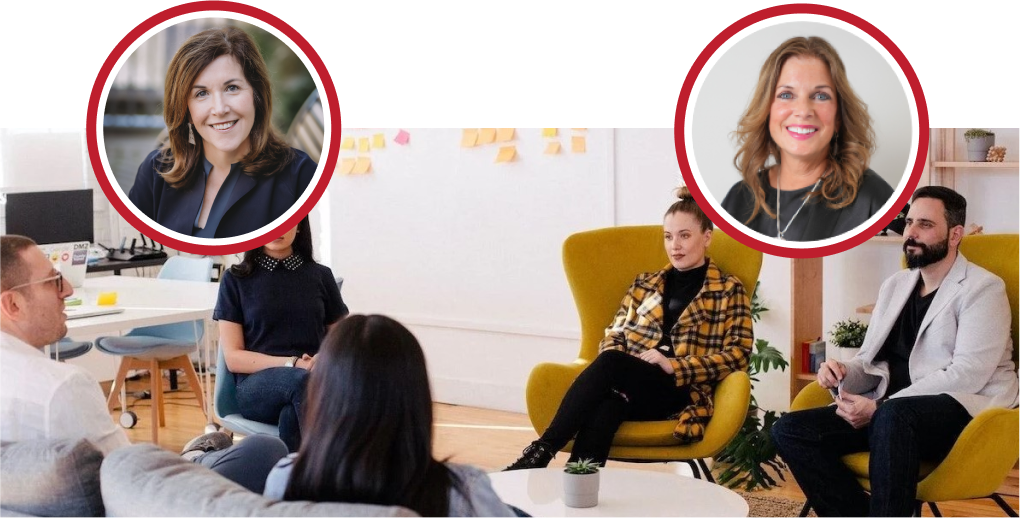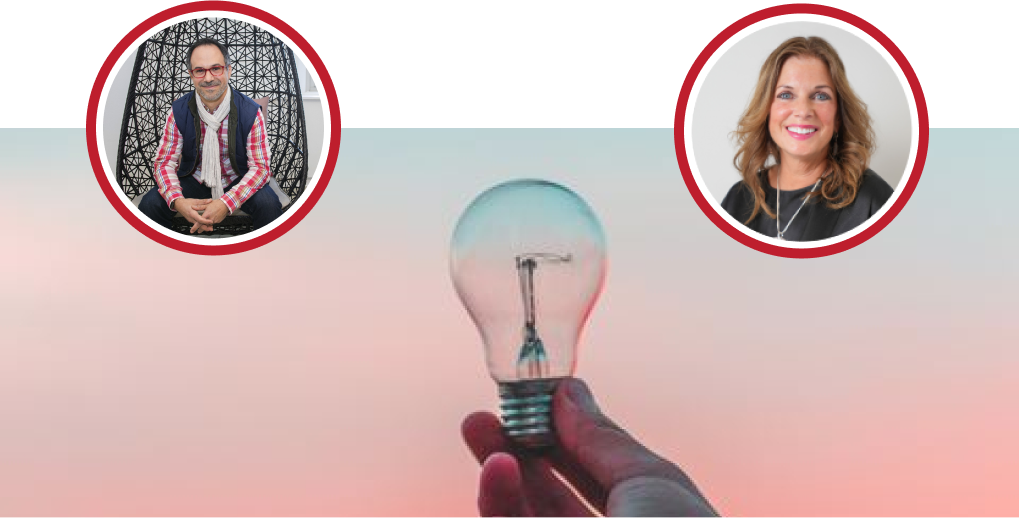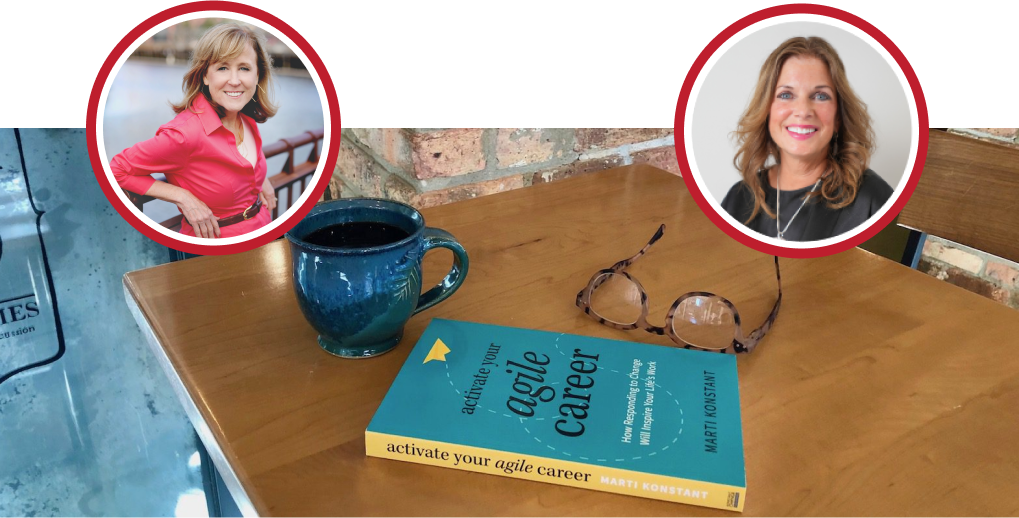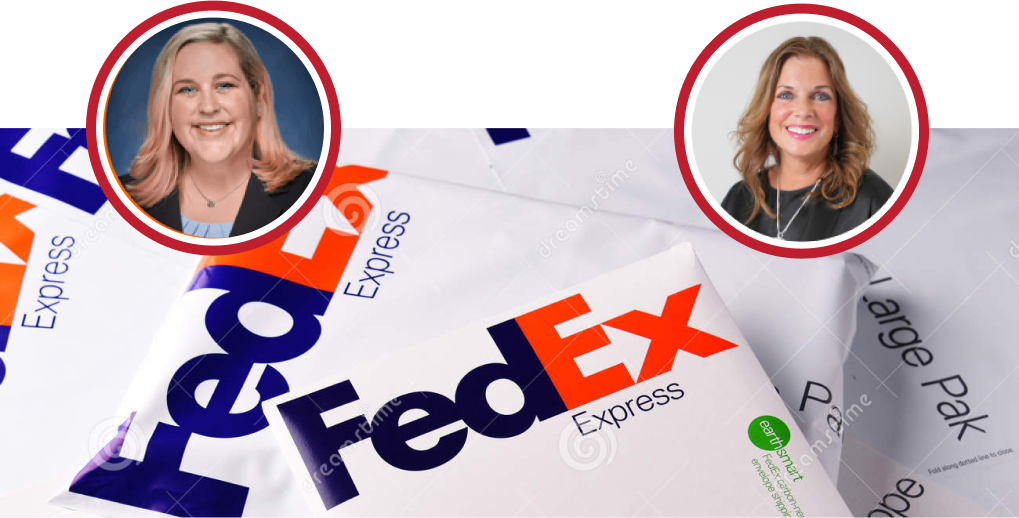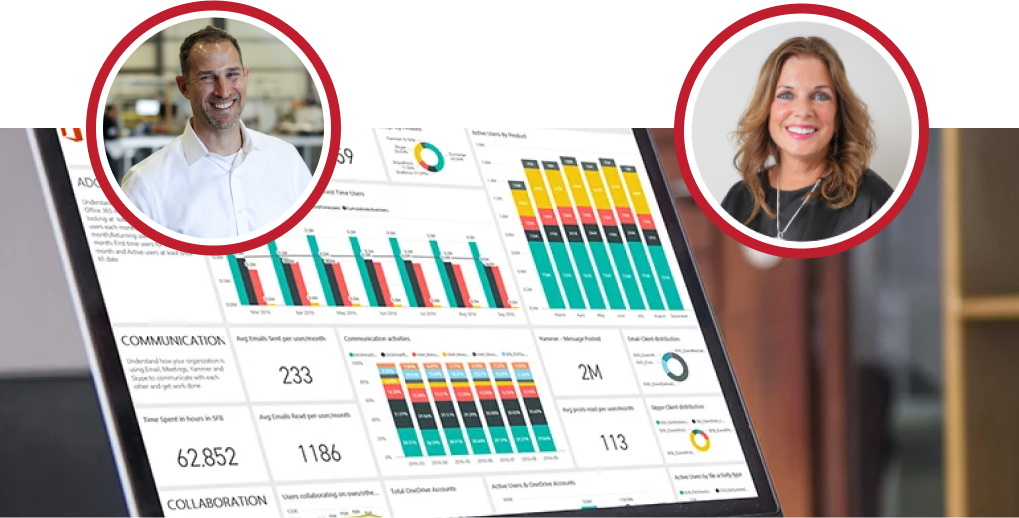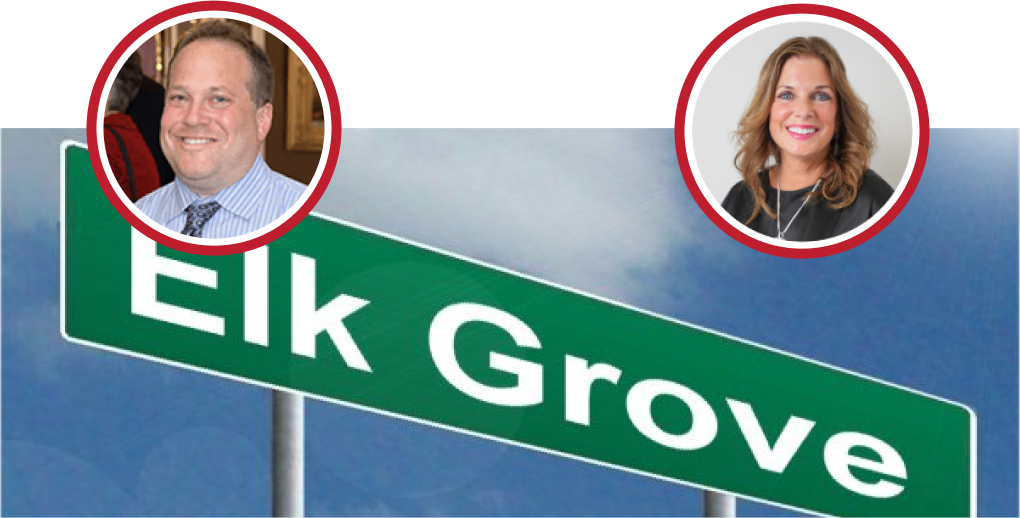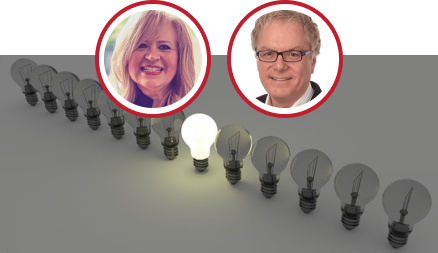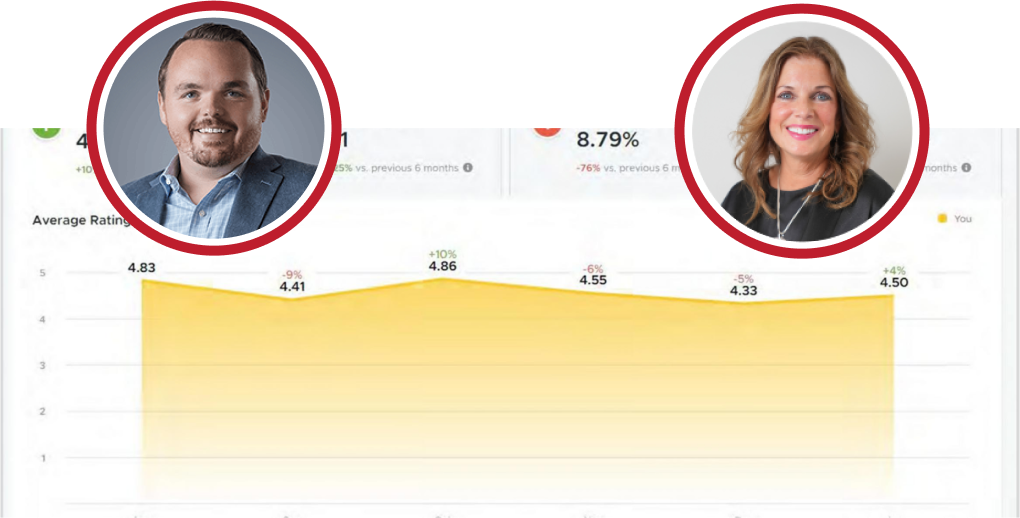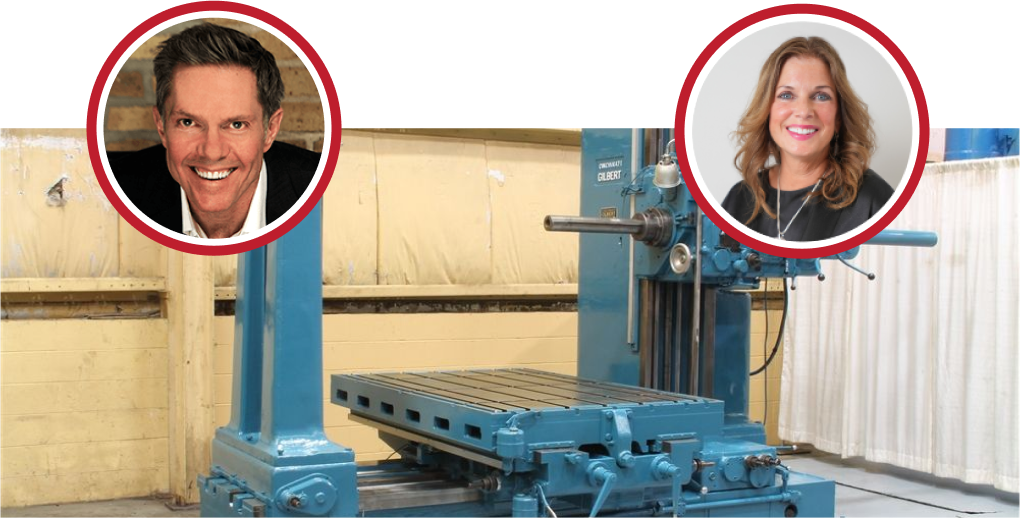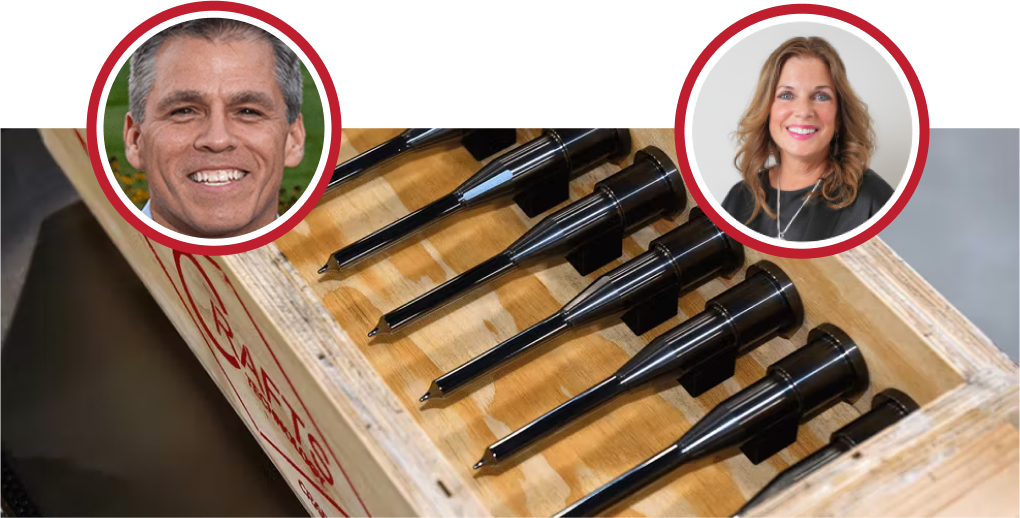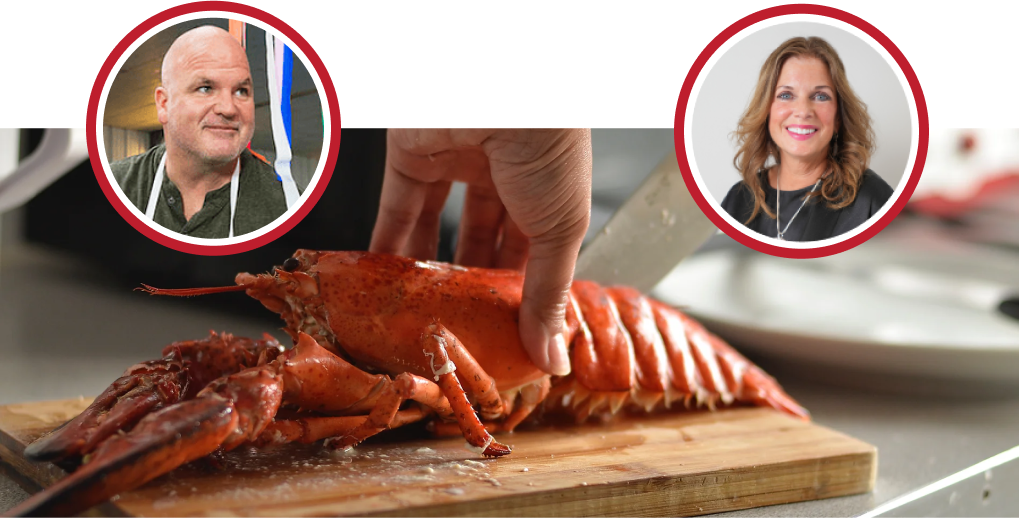Kathy: To the September session of the Business As Unusual webinar series, I’m Kathy Steele, CEO of Red Caffeine and your host for today’s session. So, a couple of housekeeping items before we jump into our session today: you can ask questions and provide answers. And to the chat feature. Suppose you’re joining us via one of our social stream channels. Please feed yourself. Questions into the chat and Dana Welters will be moderating that chat and feeding those questions to our guest speaker today. So, I’m going to kick things off with some introductions. If it’s not your first business as unusual, you may recognize my co-host, Tom Lettera. He’s a managing partner at M3 Learning. M3 works with companies as large as Google and Webex to entrepreneurial startups, and their solutions change the way your sales teams will interact with their accounts. The relationship will be at higher levels, and the tools will transform how the two teams communicate at every level of the account, giving them a framework. To engage, qualify, and close more business effectively. Tom has been a disciple of the M3 learning process since 2000, which seems like a really long time ago now. Tom, when I say that right when he was VP of Sales and Marketing at SBR Inc., he’s got over 26 years of marketing, sales, and sales.
Tom: Seems Kathy, it was a long time ago.
Kathy: Management experience and time bring such a unique real-world perspective to the M3 learning experience. Tom, welcome to business as usual today.
Tom: Thanks so much. Really glad to be a part of this program.
Kathy: Really excited to introduce a long-term friend or a friend. Our guest expert today is Rob Dubey, and Rob is the Co-founder of Image One. Image One helps clients with technology solutions to optimize and manage print-automated business processes. Secure documents and help ensure a safe and healthy work environment, but a little counterintuitive to optimizing. 10 disciplines. He is also here to talk today about his new venture. He is working with US founder Gino Whitman, and Rob is now the founder and visionary CEO of the 10 disciplines for managing and maximizing energy. 10 disciplines are video based. A journey that teaches people 10 fast, simple, powerful, and fully customized disciplines to manage and maximize their energy and live in Optima. Life robs the author of the best-selling book Do Nothing, which he knows makes me very nervous, even if that’s the name of the book. Makes me nervous, but it really is. And by all accounts of everyone who’s participated and leveraged these tips of the most rewarding leadership challenge you will ever take. He’s also the host of Leading with Genuine Care Retreat and the podcasts Rob Challenges Business Leaders. To entrepreneurs to really look inward to mindfulness and meditation by sharing their own mindfulness leadership journeys. So today, we’re going to be talking about really how to, you know, leverage these 10 disciplines in your leadership. To maximize and manage our energy as leaders. And some of the things that we expect people to walk away with today is, you know, really understanding that long-term thinking can provide perspective and bring you more energy, being able to accept who you are and try to instead of trying to be someone else will also give you back more energy. And then by protecting how you spend your time. Before work hours, it allows you to focus on growing your company, so welcome to both of you today. So, Rob, tell us. A little bit of something that is not on your bio.
Rob: I am married for. 30 years this year, I have two children, 27 and 23, and my wife and I live in Northern Michigan, a very small town with a population of 1200. We always dreamed we’d be able to move up here in, in, in the northern part of our state. Here in Michigan, we raised our kids in the Detroit area. So, I bring that up because, you know, I have a clear mind because I’m around nature, and I’m around Lake MI, and it helps me with my energy, which is a good deal of what we’re going to talk about today. So, thanks for having me, by the way. This is so amazing. I really appreciate you, Kathy, and Tom, and I’m excited to share these 10 disciplines with everyone who’s been able to join us.
Kathy: Today was one of the people that introduced me to. Neural operating system. I wish I would have jumped on it right after the phone call we had many, many years ago it took me.
Rob: I remember that.
Kathy: A little bit. Slower. I’m always kind of a slow starter, but it has been a game changer in my organization and many of our client’s businesses. I am also really excited to level up by using these 10 disciplines, or at least. Understanding where I sit with these 10 disciplines will help me get more energy back into my life and business. So. A little bit. About Red Caffeine, we’re a growth consultancy, and we help leadership teams now. Have a great day. You know which is their most optimal opportunity for growth, but one of the things that we find in many cases is that working with us or working on growth initiatives is not financial. A barrier is not always financial. It tends to be a lot more about people’s time, so even if your business is not running on E OS today, I think it is one of the most challenging resources we all have as leaders of organization. I am getting back time in our life, and I am really thrilled to jump into today’s session. So, we’re going to go into a slightly different format. Usually, Tom and I are going to be asking the questions, but we’re going to flip the script, and Rob’s going to take us through this very interactive session. Of all the different disciplines, Tom and I will be rating ourselves on this leadership discipline. And we’re going to see what areas we really need to work on in our business and personal lives.
Tom: We’re going to lay ourselves bare, right?
Rob: There you go. There you go. Chad, I’m going to pick on you guys a couple of times, but again, thank you, and you know, for everyone out there, hopefully, you have a worksheet that was sent to you because, you know, I’m hopeful that you’ll participate here and not just listen to me talk the whole time that will get boring real fast. This is about you and so, you know, use this. Time to just. Sort of clear everything out, you know. Turn off your phones. Quiet, maybe turn them over. Turn your notifications off. I mean, you showed up. So, what the heck are you? Might as well. Be fully, fully present, and make the most out of this, and I hope I give you something to think about by the end. You know, let me first just mention a little bit. About the 10 disciplines and what they actually do. Because they’re much more than what you might think at the surface is like a productivity thing. They are really our goal here is to really help you create freedom in your life and to allow for your creativity to flourish. We want it to spark, and when that starts to happen. You really get a clearer understanding of how you can make a true impact in this world, and as we like to say so, you live in. FLOWT, it’s likely you never heard the word spelled that way. That’s because we made it up and I’m going to share with you what that means in a moment here. So, what we’ll accomplish during our time together, at times, I might go kind of fast because we are kind of tight on time, but I’m just going to do a little add-on to what? Kathy shared about me. I’m going to talk about flow and what it does. How does energy fit into it? Kathy mentioned energy a moment ago. I’m going to share with you what the 10 disciplines are and are not. And then, as we go through each discipline, you’ll notice there’s a root statement, as we like to call it. And the root statement is if you just did that. You’re mastering it, so that’s that. It’s like a simple statement for you to remember. And if you just do that, you’ve got the concept. And finally, you’ll assess yourself. So, if you don’t have the worksheet, just grab a piece of paper or something that you can, even if it’s a post-intones, just so you can scribble a couple of things. It will be. Really easy, so very quickly. Just to add a little bit about what Kathy said about me, what Kathy shared and what I kind of shared about my family is that’s my outer world, and most of us, at this point in our careers, are on this. We have likely mastered the outer world. You know we’ve done some good things in our lives. We’ve had a measure of success. You know, maybe we have good incomes at this point, and we can go, and we can do things and have some unique experiences, and we can have things, and you know, all the things that you know, you kind of strive for when you’re young, and you get going in your life. And those are all great things By the way, I think they’re very, very. Important, but the next part to it is you kind of get to those success points, I guess for lack of a better way of saying it, you start to many, you start to feel as a little empty like something’s missing like I’ve reached the top of the mountain or I’m darn near close to it. It isn’t everything I thought it was going to be. It’s really great. It’s comfortable, but it isn’t. Everything I thought it was going to be and. What’s missing for many of us is just a little bit more focus on our inner self. And so that’s, believe it or not, what the 10 disciplines really help us to do, and I’m going to explain a little bit more about that. But I want to share about my inner self because I had a great deal of trauma. That I experienced growing up, and that led to a lot of stress and anxiety in my life. as I got into my adult years and started my company, my first company in 1991 with my best friend Joel Pearlman. You know, starting a company is stressful, and when you already have that sort of default mechanism in place, you know you don’t show up that great. And I wasn’t showing up. Great. I got married. I wasn’t showing up great as a husband. I was always on edge. I was always stressed out. Of course. Then we had our first child. Same thing. I knew deep down something wasn’t right. I didn’t have a strong enough foundation in my life at that point, but I knew I needed help, and that’s when I started my inner work journey, and that continues for what I believe will be the rest of my life. One of the things that happened to me along the way that has to do with building that strong foundation I mentioned a minute ago is I became a client, one of Gino Wickman’s first clients in the US. So, for those of you who are familiar with the OS, we were one of the first clients, and Gino worked with us directly. The two of us struck up a. Friendship, and over the. Years we got together for coffee a few times a year, and we would meet for about 1/2 a day. And you know what? I started to notice that he had a lot of discipline in his life. He never defined him. But just in the course of our conversation, you know, he would share some things, some ways that he was living his life. And I was really interested in them. And so I started to glean those disciplines that he had from him and incorporate them into my life. And what I know. This started to create some freedom for me to open up space to really do some good work and my creativity would spark. And then I started to notice how I could really make a greater impact, not just in my business, but actually in my life. And again, that’s what these disciplines are all about. Later, Gino, actually. Put them together and we have an eBook that you could get at the tent disciplines.com. And that’s it. It outlines every single one of the disciplines. So if you miss something today, you know, then you can grab the ebook, and that will sort of build on it for you. And now we’re partners in this. We’re taking this to the world we want to; we really want to take this to 1,000,000 entrepreneurs and get them on this journey. Because it’s so meaningful. So I mentioned this word float FLOWT, and you might have noticed by now I’m looking down at notes because I’m always afraid I’m going to miss something, so please bear with me when I do that. But as I mentioned, float is a word that we created, and it means that you have the ability in your life all of a sudden to to kind of flow. Through life, so much so that it kind of feels like you’re floating in a way, but it doesn’t mean that everything is going great because that’s just not how life goes. But it means that all of a sudden, we have a really strong mental capacity to handle what’s coming at us. We have a sense of ease and imagine that because we get ruffled a lot when things don’t go our way, or it’s not a tidy bow. Now imagine what that might feel like if you were in float. You just handled things like it like it was just so useful. And the other thing I want to. That that Kathy brought up was this idea around energy. So, I just want to kind of define what energy is as it relates to what we’re talking about here. Well, you know, first of all, and I want to caveat this by saying, you know, you can call this spiritual, you can call this scientific, you could call it religious. It comes from. All kinds of places, and it’s Nothing that we made up, and we just bring it together in a secular manner, really more than anything. But energy is your power source. It’s connected to you; it’s your soul. And it flows freely if you allow it to. But so often, especially with high performers, it’s blocked. Our energy is blocked. One thing that I’ve learned about working with high performers is they recognize when their energy is blocked, and they do everything possible to make sure that it isn’t. Because they realize managing that energy force is so vital to how they show up in this world, both in business and in their person. Real life, and when that happens, that’s when that true creativity sparks. It begins to really flow freely, and quite frankly, it could be endless. And so these 10 disciplines that I’m going to share with you create the foundation that allows for that to happen. But we need that strong foundation in our lives now. One thing that you notice is that you will notice as I go through this. It’s really fast. They’re very powerful, and they’re fully customizable to your unique self. So you just have to think about how I’m going to incorporate this in my life. So this is for you. To incorporate the way you see best, but what I will say is when you hear them, they might sound kind of easy, but I will promise you without proper effort, they are not easy. We have a community group coaching program. We have two groups, and people come to us for help with this so they can master it. They may often say they’ve tried on their own. They realize this is very challenging to mask. So OK, I’m going to jump in, and it starts with discipline #1, which is 10-year thinking, and. The root statement here is simply to shift your mind from short-term thinking to thinking in 10-year time frames. Now the first way I’m going to describe this. Do I actually want to have you participate with me for a second? I want you to, just maybe, if you’re comfortable, just kind of close your eyes for a minute and think ahead 10 years. And for many people, this is a very hard thing to do. But so just do your best. But think ahead 10 years. So it’s September 15th, 2032. Now, just grab your age. If it’s not too painful, depending on how old you are, grab your age. How old are you on that day? And then think of maybe one to three things broadly speaking or they can be specific of how your life looks, what’s happening, what does it look like? OK, there you go. You just thought in a 10-year time frame. I just took you there. If you did the exercise, you were 10 years into the future. So congratulations. That’s it. It can be literally as simple as that, but we’ll break it down for a minute. The next thing I want to share with you about 10 you’re thinking is on the business side of things. And Gino’s mentor, his name was Sam, Kopp said. He passed away. He taught him about the 10-year business cycle, and that’s where in every 10-year business cycle, you’re going to have two great Years, 6 good years, and two terrible years that could literally put you out. Business and simply stated you just want to be prepared for those two terrible years because they are coming. You could go back 100 years, and you can see like clockwork pretty much every 10 years, something happens. There’s a war, there’s a recession, there’s inflation911.com crash, pandemic or sometimes kind of like how we’re experiencing now. It could be like a lot of things at once. That’s pretty unique, but that can happen. And I want to. To share a personal story about my company, the one I founded back in 91, which is image one, we were cruising coming into 2020. I mean, we were just absolutely having the best years of our life and we were poised to do the same coming into 2020. And when the shutdown. Came in March of 2020. You know, as Kathy mentioned, we provide companies with multifunction printers, copiers, and document workflow software, and they weren’t in their offices. And when people aren’t in their offices, they’re not using the equipment that we sell them, and that’s our whole livelihood. You know, we thought we were going to be down to 0 in revenue, thank goodness. We were only 60% down in revenue, which sounds crazy, but we were actually excited about that. The thing that helped us through is that we had a very clear picture 10 years into the future, and we were very prepared for those two terrible years. And so once we got kind of through the shock of what was going on that we all experienced and the reality hit us of what it was, we were able to. We kind of got in a good groove because we knew we were prepared to get through a couple of years of this and then get back on. Track and just having that 10-year thinking slowed things down for us, and it actually helped us make better decisions throughout that period of time, and we were able actually to do some really great things. We acquired because many companies in our industry weren’t prepared, and we were able to really hone in. Amplify our culture even more than we had previous to that. And so we were able to do some really great things and come together strong as a team. So, I just use that as a personal story. So maybe you can relate to it, but I’ll leave you with this on 10 years of thinking. This you know whether it’s in your personal life or your business, or hopefully both. Remember, time slows down. You know, we want things so badly now, now results. Now I need it. And when we take a moment to think out into 10 years, we know we’ve got time, and we know when we know we have time. We have some Peace of Mind. And when we have that, we tend to make better decisions. When you have a clearer mind, you know you make better decisions, and what ends up happening, you get there faster. So, let’s pause here now. You’ll take a moment, and I’d like to ask you to rank yourself from one to 10 on your ability and how you’ve incorporated 10 years of thinking into your life. Once you haven’t done it at all. And 10 is you’re absolutely masterful. And then if you’re below, if you’re 7 or below. Take action, so just write one thing that you can do, like in the next week, to take a step in the right direction, whether to enhance whatever it is you’re already doing or to start doing something. So I’m going. To give you 30 seconds to do that. OK, great job. OK. So, let’s move on to discipline #2, which is Kathy’s favorite. Take time off. So here our rude statement is taken. Least 100. 130 days off per year and get this. Don’t think about work the entire time. What does that mean? Well, the obvious is no. Checking in with the office, not checking your email. The less obvious is, you know, that stack of business books you’ve been dying to read that you were going to read on vacation. You’re not bringing them with you. You’re bringing something. Else, with something different, you’re not going to catch up on your business reading. Because that means you’re thinking about business. You know how after, like. Two or three days on vacation, you’ve kind of done a lot of activities, and you’re starting to feel a little refreshed. All of a sudden, your mind fills up with all kinds of great ideas. Well, guess what? You’re just going to let those ideas float around? You’re not actually going to go write them down and save them or email them to yourself or something like that or send a text to somebody on your team about them. You’re going to resist every urge you have to do what’s comfortable for you, and you’re actually going to become uncomfortable because you’re just so. Wired to be high-performing and successful, this is what your default is, and so we want to change that. We want to truly open up space in your life to understand the beauty that surrounds you. Every aspect of it, and it’s going to go beyond business. You spend so much time on business. We’re going to refresh ourselves here in the true sense of the word. Now, if 130 days sounds like a lot, let me put it in perspective for you. If you took every weekend day off. Every US holiday and three weeks of vacation, you’re darn near 130 days. So many of you are probably doing something like that. You’re probably working on one of the weekend days. That’s what I find often. But you’re doing something like that. And so if it’s not 130 for you. Maybe it’s 100, whatever it is. The challenge for you will likely be not thinking about work the entire time, but that’s the challenge I want to present to you, and I think it’s a challenge worth taking. I think once you. Get in the. Groove with it; you’re going to be very happy that you did it. It will be uncomfortable at first, but you will get into your group because you want to learn how to be fully present. With what you’re doing and with the people, your loved ones, or whomever that you’re with, you need to recharge your batteries in the truest sense of that. Recharge your batteries. You know you will come back with so much more energy. As I talked about earlier, the importance of that energy. So, I’m going to ask you all to take a moment sort of and do a ranking for yourself. One to 10, one is you’re not taking time off at all or and or. When you do, you’re thinking about work the entire time, and 10 is you. When you take time off, it’s darn near over a hundred 130, and you are not thinking about work. You’re very disciplined about that. So, take a few seconds to do that. And then, if you’re 7 or below, just make a little action item. Maybe that you can take in the. Next week might just be OK. I’m taking a vacation in December, and I am committing at this moment for one week. I will only think about work for two of those seven days. It’s all about baby steps. And Kathy, I want to pick on you with this one. What was your number?
Kathy: I think 5, to be honest with you, because. I do them. I travel a lot. I do take. It’s time off, but I always read a business book or seven, and then I don’t really sort of completely disconnect. I usually sort of have that hybrid. I’m off and doing things, and then I will check in and get back and engage. So I think I am my. To do it really. We spend more time with my grandkids because they make me not touch any devices I have. I have to be pretty fully focused and present with them, so that’s why I enjoy them so much. But that was an interesting caveat that even a business book. So I thought, being.
Rob: You know, I know. All right. The challenge is there, I’ll be your accountability, buddy, if you need one. You.
Kathy: All right.
Rob: Just let me know.
Tom: I was going to. Share just really quick. I used to find, you know, I would bring my laptop, and I would think to myself. Well, I’ll just answer emails when the kids are asleep and my wife’s asleep. And then before, you know, at 9:30, ten o’clock. I’m still going away. And the families are waiting. And then they would end up doing breakfast without me. And you, I think about all those times that I missed because I didn’t commit to that. It’s heartbreaking.
Rob: Yeah, it’s so good. So good. Yeah, it is. It is. You’re right. So, let’s not let that happen anymore.
Tom: OK.
Rob: Thank you for sharing that, Tom, and thank you, Kathy, for being vulnerable.
All right, so let’s move on to discipline #3, which is to know thyself, and the root statement here is BYU 24/7, 365 days a year. BU, it’s so important. To fully get to know yourself, I want to use this example. I’m going to ask you to visualize something for a moment kind of, and I want you to imagine that I’m going to take you through two scenarios. The first scenario I want you to imagine is that you’re at an industry meeting. And there’s a pre-meeting cocktail party, and you’re at the hotel, and you find yourself walking down the hall. You’re about to enter the cocktail room, and you sort of pause at the doorway and scan the room. It’s kind of a new industry meeting for you. And so, you don’t see a lot of familiar faces. Not an easy thing. Even for an extrovert, which you know, I’m more of an introvert, so this is harder for me. But even for an extrovert, you’re going to have to sort of, you know, find your way in and start to create some conversation and some connection. And once you do that, the question as you feel yourself going in there and getting into these conversations at the industry meeting at this cocktail party starts to notice in your mind’s eye: are you, are you 100% you, or do you have some filters? That is happening. Maybe you have some Armor up. Maybe you’re not being fully vulnerable. Maybe you’re not being fully yourself in that scenario. So just think of a time maybe that you found yourself there and where you fully fully you. Because of this scenario, the next one I’m going to take you through is the one where you’re going to a gathering of your closest loved ones, your family, your friends, like where you are. You like no problem and. You come to. Then you’re all at a hotel, and you come to where the cocktail parties are. Going to be, and you look at you’re at the doorway, and you look in, and you see all these people, and your heart just is so warm. You don’t, actually. Know where to start. You want to give hugs to everybody, and now you find yourself in a conversation. Are you freer in that scenario? Now, when I’m able to interact, the answer is obvious from people that I know, obviously with their loved ones. They’re more you because they’re just more comfortable. And what we’re here to challenge you is you can be you in both scenarios. You really can. One of our clients once shared quite proudly with us that he founded. He was really proud that he was a chameleon. And that he can fit himself into any scenario. But I know him differently, and he’s not a chameleon in the way that I know. Tell him. And so actually, I challenged him because I found it to be quite sad that he felt like that was a positive thing, that he could go and just, you know, be a chameleon because his true colors were beautiful. He doesn’t need to be a chameleon. He doesn’t need to fit in. He needs to be him because that’s what people will appreciate. And the last thing I leave you with here is, have you ever met somebody? Let’s just say Kathy and Tom, and I are talking, and somebody walks up, and they engage with us in a conversation, and then they walk away, and the three of us look at each other, and maybe we say to each other, was that person weird? Or maybe we say to each other. Oh, wow, that person had amazing energy. What we meant was weird energy, not authentic, not vulnerable, great energy. Full of them. You knew what you were getting the second you started engaging in conversation and as humans. We just appreciate that about ourselves. So let’s take a moment and rank ourselves on Know Thyself on a scale of one to 10, where one is. You’ve got some work to do there. You aren’t. You’re more of a chameleon than you are yourself, and 10 is. You’re always letting your true self come to the forefront, and then if you’re 7 or below, you’re just an action item that you could take in the next week. OK. I’m going to keep us moving here. Discipline #4 is to be still. This route statement is to sit in silence for 30 minutes every day. Know this is tough.
Kathy: Not including sleeping.
Rob: No, it does not include finding yourself fully awake and present sitting. In silence, you out while I have had an, I have meditation practice for 20 years. You don’t need to look like the person on the screen. You don’t need to meditate. A lot of people are very curious about meditation, and I’m going to talk a little bit about that. But the first thing I’d like to throw out for your consideration is, you know, we have. Like super Busy lives, especially high performers. Like you all. And you know, for many people, when they try this, they’ll say things to me like. Honestly, it just seems like a waste of time. I sit there, and all I can think about are all the things I need to be doing. And I’m not doing it. And I need to get up and get back to doing well. As you listen to that, you hear what the problem is. You’re just doing it all the time. Is it making progress, or is it checking boxes? I think sometimes being in stillness is making progress. And I have a great quote. It’s one of my favorites. It’s by the author, Annie Lamont. And it goes like this. My mind is like a bad neighborhood. I try never to go there alone. And I often wonder. I often wonder if that’s the reason we have trouble sitting in silence. Because hey, our minds just take control, and this is where we want to kind of be with it. Allow it to. We let our thoughts go and float by like clouds in the sky. If we can practice that, it’s not an easy thing to do, and we just try to come to the present moment. Now, it’s sitting in silence. Doesn’t work for you. You need to be more active. Something more active, you know. Another thing that you can do is some people have. A religion. Because you could do some prayers, you could pray. I mean, for 30 minutes, that connects you to something. That’s something that we hear is very valuable for people. You can journal. Some people love to journal. Just let your words fly. You know, as our Kathy and our good friend, we rewind us. Zingerman says you know, hot Pennant. I know when I journal, I can’t even read what I’m writing because it’s so messy. I’m going so fast, so if you’re not writing a novel and you don’t need to worry about punctuation or grammar or anything like that because you all are like racehorses, you go hard each and every day, and you’ve got to manage your energy. And this is a way to manage your energy. You know, we don’t have time to do it today, but when you sit in silence or even too. Minutes anytime I take anybody through a period where we just sit in silence for two minutes, and then I ask them how they feel after they say I, I feel reenergized 2 minutes. That’s all it takes. Now, I’m encouraging you to go to 30 and make it part of your routine, and I hope you will. I think it’ll be. With it, I think it will be worth your time. Your nervous system will help. Will. Thank you. Your mind will thank you. And I do believe it could be transformative for you. So. On the ranking system, from one to 10, one is you. You’re not still at all, and 10 is you do it all the time. At least 30 minutes. If you have to work your way up to 30 minutes. Of course, you’ll do that, but come up with an action plan. Maybe your action plan is I’m just going to set a timer for 2 minutes today and I’m just going to sit with my discomfort. At least one time today, or maybe every day for the next week, and then move it up to 5 minutes, something like that. So go ahead and rank yourself. OK, I’m going to move on to discipline #5, which is to know you 100% here. Our root statement is to decide on and commit to the perfect number of hours per week and weeks per year that you will deliver your value to the world. You see, this is your work container. This is the number of hours where you have the most energy, the number of weeks that you can work in a year where you know you can give it all at your highest level. Likely if you’re like most. People, you’re going beyond those boundaries, which means you’re not doing your best work. Actually, less is you. I’m not making this statement up. Less is more. And you have very specific, unique qualities. And I want you to work within those unique qualities. Well over 80% of your day, well over 80% of your year. And so, this is what we want to focus on. I’ll give you an example of a story from myself. I’m a runner, and when it was early on in our business and our team started to grow, I would part of my morning routine going for a run. and then we had meetings that started to take place earlier and earlier, and it got to the point where I couldn’t get my run in, and I had a business. Coach at the time and I said I was really frustrated because I couldn’t get my run at anymore, and he said what, why? What’s going on? I said the meetings were starting too early, and he said why do you accept the meetings? And I said I don’t want to mess anybody else up. And he said you need that run; you’re messing everybody up by showing up. You’re not. You’re your best self. So, I went to the team and I said, can we start an hour later? Because I need to get my run in. And they all said, yeah, sure, no problem. Problem solved. And that my energy was so much better because of it. So, it could be as simple as that. Think about what your version of that story is; what are the sacrifices? That you’re making, that you may not need to be doing. And then where does it end? How many times do you have one sacrifice, 2 sacrifices, and the list just keeps going on to the point where it’s draining your energy, so you must protect your time, delegate, and elevate? If you’re familiar with the OS, they talk about that a lot. This will increase your productivity, your creativity and of course. Your energy. So, let’s do that self-assessment too. 10 where one is you are so bad at knowing you’re 100% you know you’re not protecting your boundaries at all, and 10 is you’re amazing at it. So, find your number and just jot down a real quick action item. OK.So before we move on, you’re noticing these are fast. They’re powerful. They’re simple. They’re fully customizable to you, even though Kathy is committing to 130 days with no work, but you’re noticing they’re not easy. You know, they’re not easy to do without proper effort. So, I’m going to move on to discipline 6 right now, which is. Say no often, which is now that you have a good foundation with the 1st 5 disciplines, you’re going to say no to everything that doesn’t fit into those first. And you know, look, I understand you can’t say no all the time. I get it. But you can say no. You can exercise that. You know, I have trouble saying no. If you’re familiar with the anagram profiling. I’m a Type 3 Type 2. I’m the helper and the achiever. So, if you ask me, I want to help you. And then I want to achieve. I want to do the best, so you know I have to really work hard at saying no because if I say yes, I’m all in on it. And So, what I want you to think about here is maybe something in the last week or two weeks that you said yes to that you regret saying yes to you wish you didn’t. It was easy to say yes at the moment. Maybe because you’re a helper like me. But as the time came around when you had to deliver on whatever it was, you said, yes, maybe you saw a meeting on your calendar, and you thought, I don’t have any time for that meeting. Why? Did I say yes to that? Your energy drops, and you show up, and you just want to get done with it. Now, the pain that you experienced from saying no when asked is much less than the pain that you’re experiencing when you go get to that meeting and your energy drops and that dread feeling of it when you see it on your calendar. So that’s what we want to work towards here is saying no. Now two things I want to share with you. First, baby steps. If this is hard for you, start exercising this muscle by saying no 25% of the time, one out of four times. If you do that, you’re going to save. If that’s an hour meeting once a week, you’re going to save yourself 4 hours a month. There’s a simple starting point. The other thing in saying no is it’s so freon-freeing, and you’re just going to notice how your energy rises. So if somebody comes to you and you want to say yes, say no and do it with grace, provide one or two resources for them. Where they can get the help that they’re looking for, and that way, you’ll feel better. You helped, and they’ll feel better because they have direction, and they will respect where you’re coming from. I promise you. And so, with that, take a moment to make your assessment. One to 10 one is. You’re horrible. Saying No 10 is masterful and just very quickly in action. And now, because of time, I’m going to go a little fast here. But discipline #7 is don’t do $25.00 an hour work, and the root statement is never do anything that you could pay somebody $25.00 an hour to do. And I need to qualify the statement by saying. $25.00 an hour work is not less than work. It is very important work. There are many people that want to do that work. They’re. Amazing at that. Work and you are where and are happy to do it. They’re dying to do it. So, it’s important work. This isn’t what this is about. This isn’t about somebody being above or below the other. This is about your pay grade. And if you’re doing $25.00 an hour work, you’re likely below your pay grade. And so. Always just ask yourself. Whatever I’m doing right now, is this $25.00 an hour working? If so, what do I need to do to delegate it to get it off my plate and make a plan for that? You will add value to your team members or employees. You’re going to bring more value to yours. Company, and you’re going to be more strategic. Your customers are going to appreciate you more, and your loved ones are going to appreciate you more because I’m not just talking about work stuff. I’m talking about the household as well. You know, anything that you can delegate and give you more energy, say, like on the weekends or whatever. So you don’t have to take care of it. That’s going to give you more energy, so I’m going to allow you to assess on your own for the rest of these moving forward, but you get the point, and hopefully, I got you started. On it, the last three disciplines, #8, are prepared every night. Simply stated, before your head hits the pillow every night, document the next day’s plan. So whatever time that is for you when you kind of finish your workday and any time before you actually go to bed, take a look at your calendar. Look at your DOS. Just get it straight in. Your head and then put it aside; once you’re sleeping, your mind and your subconscious are going to be working for you. When you wake up, you’re going to be super clear. You’re going to hit the ground running. You may have even solved the problem or come up with a creative solution for something while sleeping. You may notice that might have happened to you in your life all of a sudden. You, you know, get to make your coffee, and you. Go. Oh my. God, I have an idea. This is what we need to do. Your subconscious was working on it while you were sleeping. So, prepare every night. Discipline. #9. Put everything in one place. Pick one place, just one where you will capture every idea, commitment, thought, action, item, and promise throughout the day. This is as simple as a notepad. One thing, not multiple notepads, multiple journals, multiple electronics. One thing. Just pick it. And as you’re in your meetings. As you’re going in between meetings, as you’re working on email, and something, an idea comes to you. You jot it down in that one place as you shut down at the end of the night, you look at your one place and you just disseminate where all those. Things go; they might go to your calendar, and you might delegate it to somebody on your team. You might take an action item that you need to follow through on in the morning, etcetera. The sad thing about leaders is that we are letting our teams down because we have so much coming at us throughout the day. We lose track of some percentage of it. And we don’t even realize it. And our team often doesn’t. They don’t call us out on it. So, we’re walking, and we’re unconscious about it. So, just pick that one place, and I finish with discipline #10. Which is to be humble and simply stated, view yourself as an equal to every person on the planet, and as you see here on that scale, from arrogant to humble, find out, just ask yourself, and be really tough on yourself. Where do you land on the scale of arrogant to humble? If it’s anywhere beyond the middle to the left, please work on bringing it up to be humble because there is Nothing in this world like a humble person. We all know who they are, and they are so wonderful to be around. And so, with that, Kathy and Tom, thank you so much. I really appreciate you bringing me here today.
Kathy: Fantastic. Really fantastic. I loved a lot of the contacts. I know we talked about this, you know, in our prep session. But I’m curious because I tend to prepare. In the morning is there an advantage to preparing at night? I like what you said about it because I do tend to wake up and be, you know, oh my gosh, I didn’t do X and then. I’m up there. Is that intentional that it’s in the evening?
Rob: Yeah, I think it’s so powerful because when you go to sleep with a clear mind, you know what? You must know what’s gonna happen tomorrow. You’ve got some problems. You must deal with it. You have some creative, creative solutions. You got to come up with you, allow you. You go in with trust, and you allow your subconscious. To do the work, allow it to. Do the work when you wake up. You’re going to be surprised; you’re going to notice more clarity; good night’s sleep. The subconscious did the work, and you’re going to have some solutions. You’re going to be very clear about what’s going on in the day, and you’ll
hit the ground running.
Tom: Kathy, there’s a great story. I heard Paul McCartney used to keep a book off to the side of his desk, and he woke up one morning, and yesterday was written. And sometimes that.
Rob: Yeah, right.
Tom: Space for letting your subconscious do the work for you. You create.
You create a song that lasts for 60 years, right?
Rob: That’s so good. That is so good.
Kathy: Yeah. What? What was it? Sort of an end half for you, Tam, in this discussion.
Tom: You know, I mean so one that prepares every night and be still. I remember reading something where an executive said that when I want to do my best thinking I think about something right before I go in the shower. Or I take a long drive, and so that space of, you know, in the shower or driving, your body is doing other things. And it allows your mind to kind of and. So I started. Doing that, it’s hard for me to just do it. I find I fall asleep, but if I kind of steal my mind, I let my mind do some. So if I’m going on a long drive, I tend to kind of go into that drive thinking, OK, I’m going to solve this problem. And I’m telling you, it’s amazing. What I’m able to accomplish sometimes I’m missing 3 or 4 exits, but that’s probably the thing that really spoke to me the most. These are just so present and so, and you recognize that these are all muscles you’ve got to exercise. It’s just great. Rob. I really love the whole conversation.
Kathy: Yeah, I did have one other question about the 100%. I thought I thought y conceptually, you know I. Really got sort of. Playing to your strikes and those types of things, but what else? And I am a huge believer in trying to put in some. You know I play tennis and do other extracurricular things just to distress myself. How do you apply that kind of thinking to sort of more business related scenarios?
Rob: So, and we’re talking about knowing you’re 100%, is that what you’re asking, yeah. You know, in a business scenario, when you’re really clear about your boundaries, whatever’s coming at you, I’ll just start there. Whatever’s coming at you, it’s much easier on your mind to make decisions because you’re really clear about your boundaries. You know, some of us expend energy over 5 minutes just trying to figure out what we should do with that. Request or whatever it might be, but when you’re really clear about it, you don’t have to think about it. So that’s one area. The other area is setting your boundaries and knowing the perfect amount of hours that you can deliver your best work in a day. And let’s just say, for the sake of this discussion. It’s 50 hours. And if you go beyond that, you’re on the verge of burnout. So knowing this, you know you have to use every one of those 50 hours very wisely. Because if you get beyond fifty, you’re not doing your best work. And that means even during the actual 50, it’s not like, oh, for 50, I’m good. And then for five or ten more, I’m not, no, it means it’s all not good. It’s all not as good. But when you are energized all day, every day, with clear mind space, that’s when you have freedom and creativity, and that’s where you really start to make an impact. I always like to say that, you know, some of the best ideas in business aren’t you, or excuse me, I like to say because we don’t have that creativity. The depth of that creativity we come up with, ideas that are actually good, but the great idea was just down a little bit more, but we didn’t have the space for it. And so it got lost. And so we have a good idea, and it serves us for six months or a year or something. And then that fizzles, and we’re trying to figure out the next thing, the real game, changing ideas of business are when you have space to really, really think and that you have to set your boundaries to have that.
Kathy: Yeah, I agree. No, we did have a question. What are some of the actions you recommend in areas where we might be under 7? Any of the 10 disciplines?
Rob: OK. So first of all, don’t feel overwhelmed because, you know, regularly I see scores like in the 50s or, you know, 60. So you know, just know that’s normal. I would say pick two that are the most challenging for you. And put your focus on those action items. Take baby steps. Let’s say taking time off without business for 130 days seems overwhelming. Let’s say right now you think you do like 20. So up, you know, move it up to 30 next. Year and stay focused on it. Get it from 30 to 60. Because you’ll start to notice how powerful it is, so just take baby steps. Don’t feel like you need to be perfect on day one. Some people do that, and they’re disciplined enough to do it. But most people aren’t.
Kathy: We’ve got another question. Are the 10 disciplines applicable to non-leaders in an organization?
Rob: It’s a tough one. I have to be honest. You know, we teach the leaders, you know, so those are the people that I’m. I’m so sure it does require, you know, the ability to control your calendar to a certain extent and be able to make it. In business, at least, to be able to make certain decisions and certain calls that could be disruptive to other people, and sometimes, if you’re in a non-leadership role, you don’t have that opportunity; that said. Bring these into your personal life. If you don’t have that control at work, bring these into your personal life the best you can and try to incorporate as much as you can. I mean, you know, depending on your income, you can look at not doing $25.00 an hour work and see how that serves your energy and maybe there are ways that you can make more money. Because you know you’re, you’re not having to do those $25.00 an hour work things at home just to use that as an example.
Tom: But Rob, think about I think about some of the leaders that I work with, and you know if one of them. Their employees came up and said, listen, I’m trying to become a better person, a better employee. I want to be more productive, and here’s what I’m thinking. What a powerful conversation that would be in the business world and, you know, knowing that that’s where my employees and they want to grow or they want to expand. I could see leaders just. Supporting that and really helping them. In a powerful way.
Rob: The ideal, you know our dream, you know, it’s kind of the small Giants community sort of dream is there’s leaders out there and there are communities like small giants where there’s leaders like this where they say. I’m incorporating this into my life. I see how powerful it is for me. I want my team to have this same thing in their life, so if you’re part of a company like that. Congratulations on finding a home like that, you know, purposeful leadership, purposeful companies like small giants, and hopefully, as, as you mentioned, Tom, you know, the leader can take that kind of this kind of framework to the team and give them the space to utilize it in their lives.
Kathy: Yeah, absolutely. Well, we are just getting close to it. OK. Time and I. Want to be aware of everyone’s schedule? Rob, I know you guys are kicking off some cohorts to help people. That’s right. Get support. Improving their disciplines or, you know, leveraging? Yes, please, please. Tell us a little bit about that.
Rob: Yes. So we open up these group coaching sessions, there’s 12 sessions over 15 weeks. There’s one open right now that closes on Monday. And this is where we have leaders come in and this is where they’re focused on mastering these. So they can, you know, really get that freedom in their life to have the space to spark that creativity and make a true impact in this world.
Tom: And Robbie doing this virtually or in person and.
Rob: Yeah, it’s all on Zoom. Yeah. One-hour commitment for 12 sessions over 15 weeks. Thanks for that.
Tom: It’s really nice. That’s great.
Kathy: And so we’ve got robbed. Contact information is up here if you want to reach out to Rob and get any more. One-on-one feedback on the 10 disciplines: please reach out and put business as unusual in the subject line of your message via LinkedIn. So Rob knows that you are coming from our session today. And then I do believe you’re going to be at the OS conference. Summit in April next year. So, for all of the CEO S businesses, please look for Rob and, you know, connect with him on the 10 disciplines next.
Rob: That’s right.
Kathy: Hey there. Year at some. And thank you so much. We’re going to talk about what’s coming in October. Well. But first, I couldn’t. I wouldn’t want to forget to thank our sponsors and sparsity HR source and, of course, Tom from M3 Learning, and then our next session is going to be. In October, we are going to be talking with Tim Schum. He is the founder and president of Lucas James. Partners, and he’s going to be talking about talent strategies in a recessionary environment. I think all of us who have been hiring and looking at building our teams out have been through so many different ups and downs, and now we’ve got a new caveat to the hiring process. So Lucas. James Talent Partners offers a really unique approach to antiquated recruitment and industry. So he’s got some really great ideas. It is cost-effective, and you know different ideas for building your team in a recessionary town time as well as in growth times as well. So he is just a fun guy and a real rock star in the talent space. So I hope. People will join us to hear Tim’s perspective. What to do in your hiring for 2023? So thank you again, Tom, for joining us as my co-host. It was just a pleasure to have to bring this to our breakfast group and see how our friends from small giants and and.
Tom: Very great conversation.
Kathy: Executive breakfast club. Rate themselves on you.
Tom: Well, what’s great about this conversation is I don’t care what age you are, you’re going to say I wish I did this ten years ago.
Kathy: Exactly. Exactly. Exactly, Rob. Such a pleasure to see. You again, I really, really appreciate it. I.
Tom: Same, same.
Kathy: I look forward and wish you guys the best of luck in your cohort; I will see what the summit is. So, all right. Thanks, everyone.
Rob: Thank you so much.
Tom: See you there.
Kathy: Great day.
Rob: You too.
